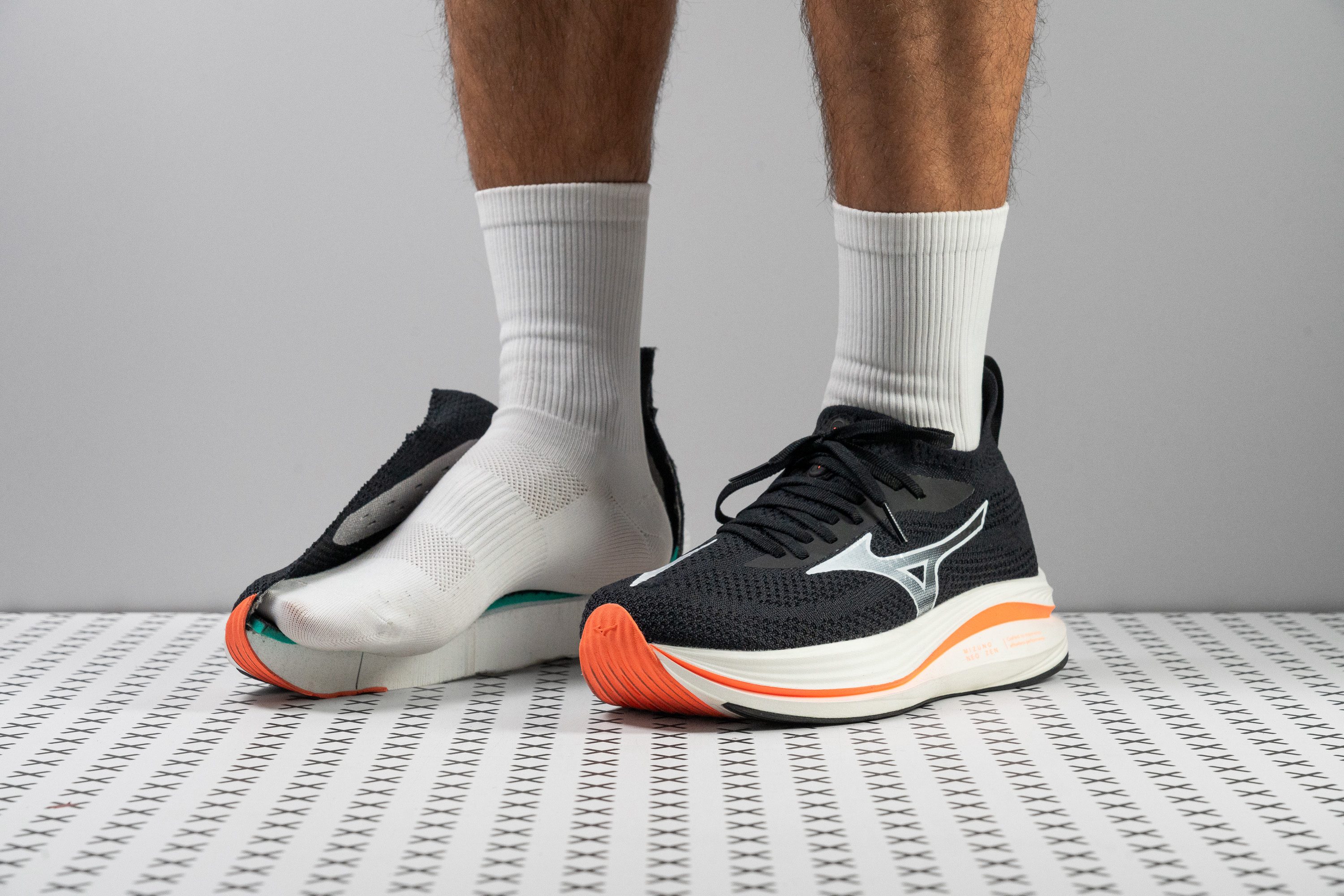Nuestra conclusión
Pros
- Espuma mullida y con rebote
- Muy ligeras para lo altas que son
- Pisada ágil y divertida
- Ideales para carreras largas
- Buena relación calidad-precio
- Upper de knit cómodo y transpirable
- Parte delantera resistente al desgaste
- Diseño llamativo
- La suela exterior es duradera y tiene agarre
Contras
- Inestables para los que necesitan sujeción
- El talón se hunde y frena a los talonadores
- Al upper le falta acolchado y estructura
- La espuma Enerzy NXT se vuelve más firme con el frío
Veredicto de los usuarios
- Top 2% entre Zapatillas de running para asfalto
- Top 2% entre zapatillas de running neutras
- Top 22% más vendidas zapatillas de running
Comparativa
Las zapatillas de running más parecidas
+ + Añadir unas zapatillas | |||||
|---|---|---|---|---|---|
| Puntuación global | 93 Excelentes | 91 Excelentes | 86 Buenas | 89 Notables | |
| Precio | 150 € | 190 € | 160 € | 160 € | |
| Pace | Correr a diarioTempo / series | Correr a diario | Correr a diario | Correr a diario | |
| Absorción de impactos | Alta | Alta | Alta | - | |
| Retorno de energía | Alto | Moderado | Bajo | - | |
| Tracción | Moderada | Moderada | Alta | - | |
| Arch support | Neutral | Neutral | Neutral | Neutral | |
| Peso laboratorio Peso marca | 8.3 oz / 234g 8.5 oz / 240g | 9.6 oz / 271g 9.8 oz / 277g | 9.1 oz / 258g 9.3 oz / 265g | 9.6 oz / 272g 9.4 oz / 266g | |
| Lightweight | ✓ | ✗ | ✗ | ✗ | |
| Drop laboratorio Drop marca | 7.0 mm 6.0 mm | 10.0 mm 8.0 mm | 8.3 mm 10.0 mm | 6.5 mm 4.0 mm | |
| Técnica de carrera | Medio/antepié | TalónMedio/antepié | TalónMedio/antepié | Medio/antepié | |
| Talla | Tallan bien | Tallan bien | - | Tallan bien | |
| Rigidez de la mediasuela | Blanda | Blanda | Blanda | Equilibrada | |
| Diferencia de la rigidez de la mediasuela en frío | Normal | Normal | Normal | Normal | |
| Durabilidad de la parte delantera | Buena | Buena | Decente | - | |
| Durabilidad del acolchado del talón | Alta | Alta | Alta | - | |
| Durabilidad de la suela exterior | Buena | Mala | Decente | - | |
| Transpirabilidad | Media | Media | Media | Media | |
| Anchura / ajuste | Media | Media | Media | Estrecha | |
| Anchura de la parte delantera | Media | Media | Ancha | - | |
| Flexibilidad | Moderada | Moderada | Moderada | Rígida | |
| Rigidez torsional | Moderadas | Moderadas | Rígidas | Moderadas | |
| Rigidez del contrafuerte del talón | Flexible | Moderado | Rígido | Moderado | |
| Rocker | ✗ | ✗ | ✗ | ✓ | |
| Talón laboratorio Talón marca | 41.0 mm 40.0 mm | 40.7 mm 42.0 mm | 37.5 mm 39.0 mm | 39.6 mm 39.0 mm | |
| Antepié laboratorio Antepié marca | 34.0 mm 34.0 mm | 30.7 mm 34.0 mm | 29.2 mm 29.0 mm | 33.1 mm 35.0 mm | |
| Anchuras disponibles | EstándarAncho | EstándarAncho | EstándarAncho | EstándarAncho | |
| Orthotic friendly | ✓ | ✓ | ✓ | ✓ | |
| Estación | Todas las estaciones | Todas las estaciones | Todas las estaciones | Todas las estaciones | |
| Removable insole | ✓ | ✓ | ✓ | ✓ | |
| Clasificación | #5 Top 2% | #25 Top 7% | #193 48% inferior | #109 Top 30% | |
| Popularidad | #79 Top 22% | #207 44% inferior | #130 Top 35% | #218 41% inferior |
Quién debería comprárselas
Les hemos hecho pruebas a las Neo Zen tanto dentro como fuera del laboratorio, y nos parecen una opción estupenda para:
- Los corredores que están buscando unas zapatillas de entrenamiento diario con una suela alta que combinen comodidad, diversión y rendimiento de una forma única.
- Los que necesitan un par duradero para el día a día con el que poder hacer ejercicios de tempo cuando sea necesario gracias a su estructura ligera.
- Los maratonianos que quieren una opción muy blandita y que no les canse las piernas para las tiradas fáciles y los días de recuperación.
- Las personas a las que les flipan los uppers de knit.

Quién NO debería comprárselas
Creemos que las Neo Zen no son la mejor opción para los corredores que necesitan estabilidad o una mayor sensación de contacto con el suelo. Después de analizarlas, descubrimos que su espuma blandita hace que sientas que te estás hundiendo, lo que puede ser inestable para muchos corredores. Si estás buscando una pisada mullida y equilibrada, te recomendamos Hoka Clifton 10 o las Adidas Adistar 3, ya que ambas tienen una plataforma más estable para el entrenamiento diario.
Además, creemos que el upper de knit, aunque es elástico y transpirable, carece de la estructura y el acolchado que algunos corredores se esperan en unas zapatillas de entrenamiento diario: en nuestra experiencia, el ajuste del talón puede ser flojo. Si estás buscando unas zapatillas con un rebote parecido pero con una sensación más tradicional y segura, te recomendamos probar las ASICS Novablast 5.
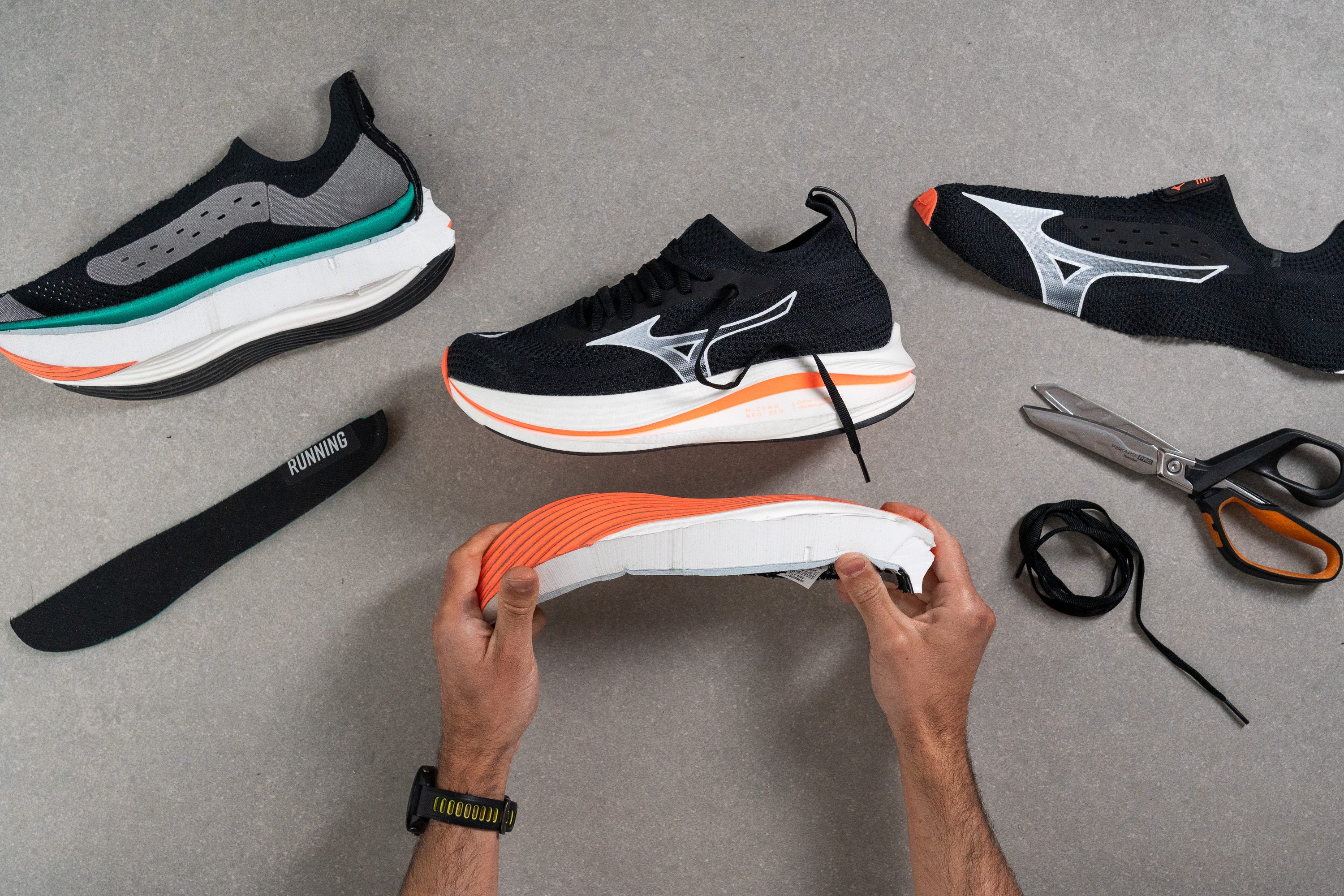
Amortiguación
Shock absorption
Si estás buscando unas zapatillas de entrenamiento diario que te protejan muy bien las articulaciones, las Neo Zen son una opción estupenda. Cuentan con una capa de espuma muy gruesa que alcanzó unos impresionantes 158 SA en nuestra prueba de laboratorio, superando a la mayoría de sus competidoras. En el antepié se llevaron un resultado de 129 SA, superando también a la media.
Sin embargo, este diseño de amortiguación máxima también tiene sus desventajas. Si eres un corredor ligero o prefieres una sensación más conectada con el suelo, probablemente sentirás que hay demasiado acolchado bajo tus pies.
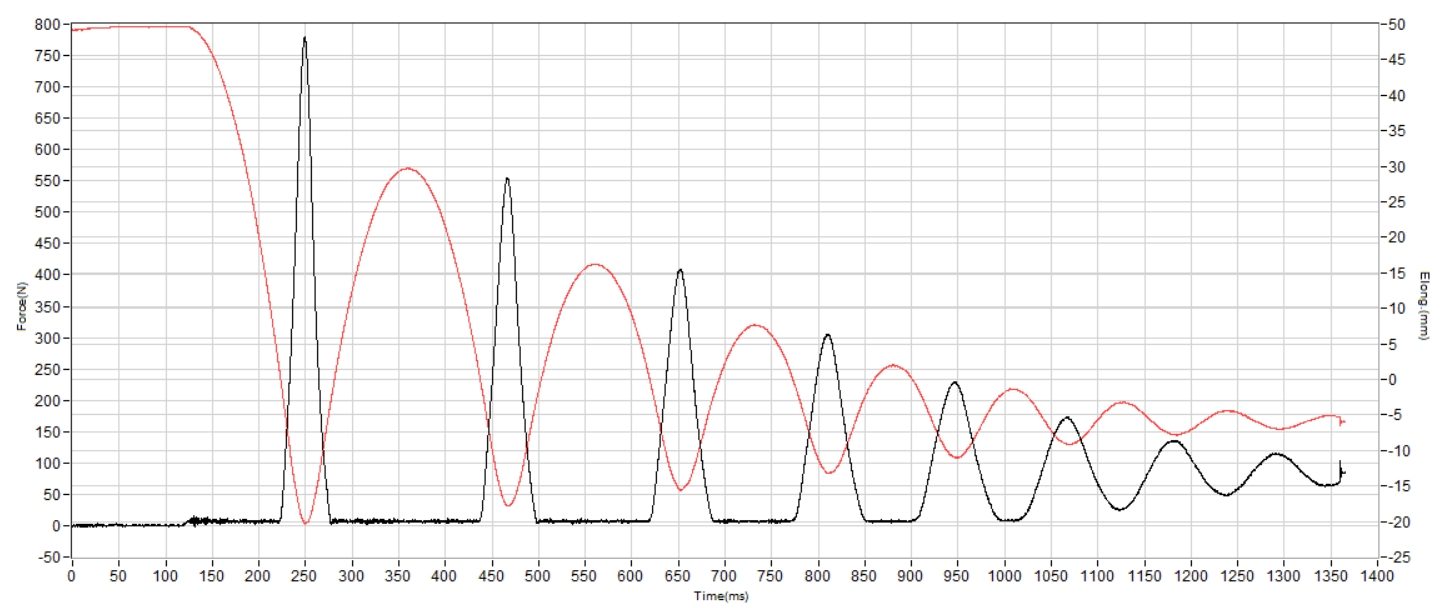
| Neo Zen | 158 SA |
| Media | 129 SA |
Energy return
Una de nuestras mayores críticas a las primas de estas zapatillas, las Neo Vista, fue su decepcionante retorno de energía con la espuma EVA básica. Por eso Mizuno optó por una mezcla de TPU supercrítica, que es una mejora que creemos que ha valido mucho la pena. Cuando medimos su rebote, vimos que era del 71,7 % en el talón; este resultado es parecido al de las superzapatillas, lo que nos parece un gran avance.
| Neo Zen | 71.7% |
| Media | 58.5% |
Altura de la suela en la zona del talón
Todos sabemos que las zapatillas de running son cada vez más altas, y lo vemos a diario aquí en el laboratorio. Pero..., ¿un modelo de entrenamiento diario que supera los 40 mm? Pues antes aún nos sorprendía, pero ahora se está convirtiendo hasta en algo normal, y las Neo Zen nos lo han demostrado.
Cuando medimos la altura del talón, nuestro calibre marcó 41,0 mm. Esto hace que estas zapatillas sean maximalistas, así que son ideales para las personas que no quieren sentir el suelo bajo los pies o para los corredores más pesados, que necesitan una experiencia llena de amortiguación y respetuosa con las articulaciones.

| Neo Zen | 41.0 mm |
| Media | 34.8 mm |
Altura de la suela en el antepié
Con 34,0 mm, el antepié es incluso más impresionante que el talón, sobre todo si lo comparamos con la media de las zapatillas de running. Sea cual sea tu técnica de carrera, siempre disfrutarás de un montón de espuma bajo los pies.
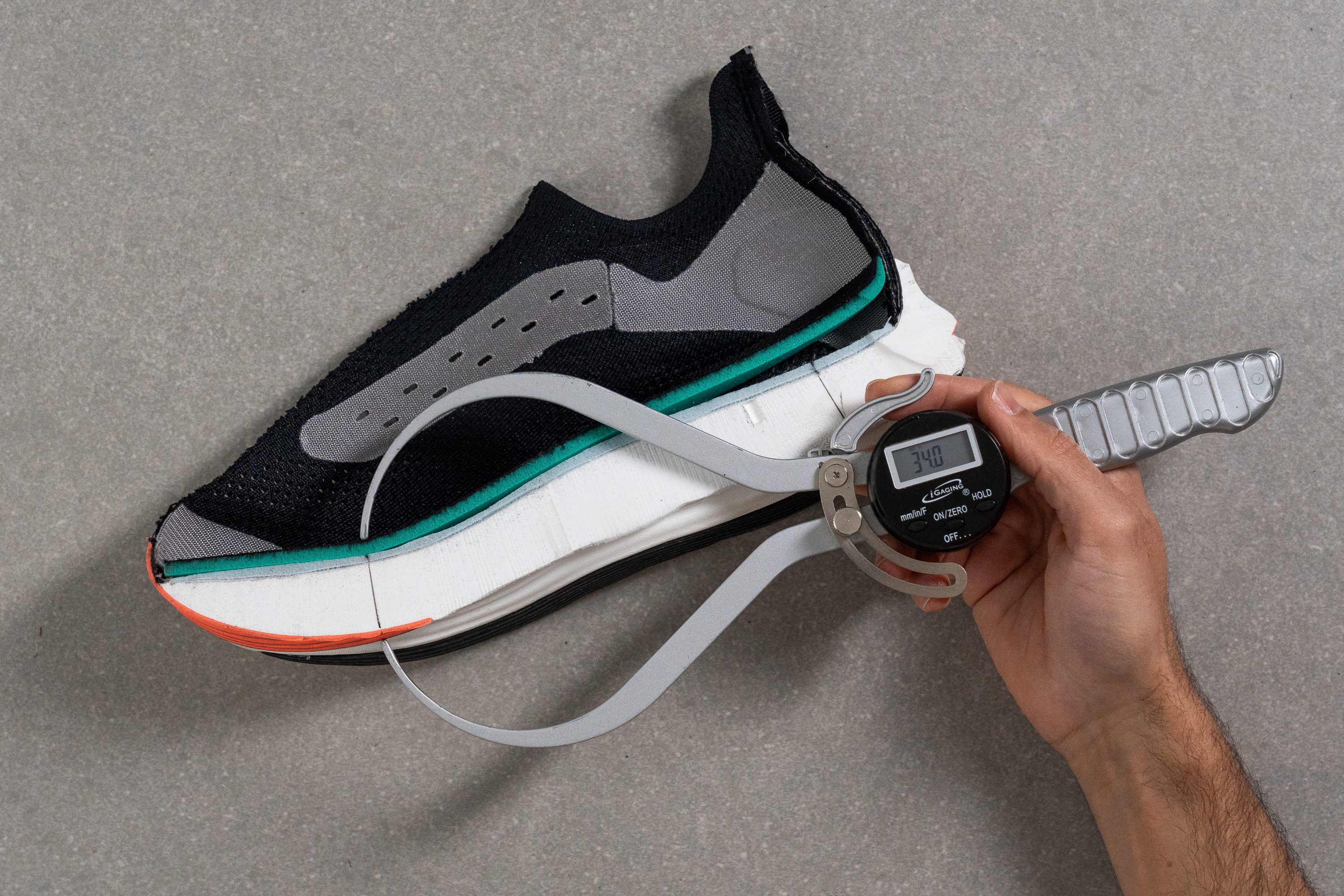
| Neo Zen | 34.0 mm |
| Media | 26.2 mm |
Drop
Cuando medimos el drop, el resultado fue medio: de 7,0 mm. En teoría, es ideal para cualquier técnica de carrera, pero estas zapatillas no nos parecen la mejor opción para los talonadores, ya que su retropié es muy blandito y hace que sientas que te estás hundiendo, ralentizando así el impulso.
Por otro lado, los corredores de mediopié y de metatarsos disfrutarán de una pisada llena de fluidez, energía y muy natural.
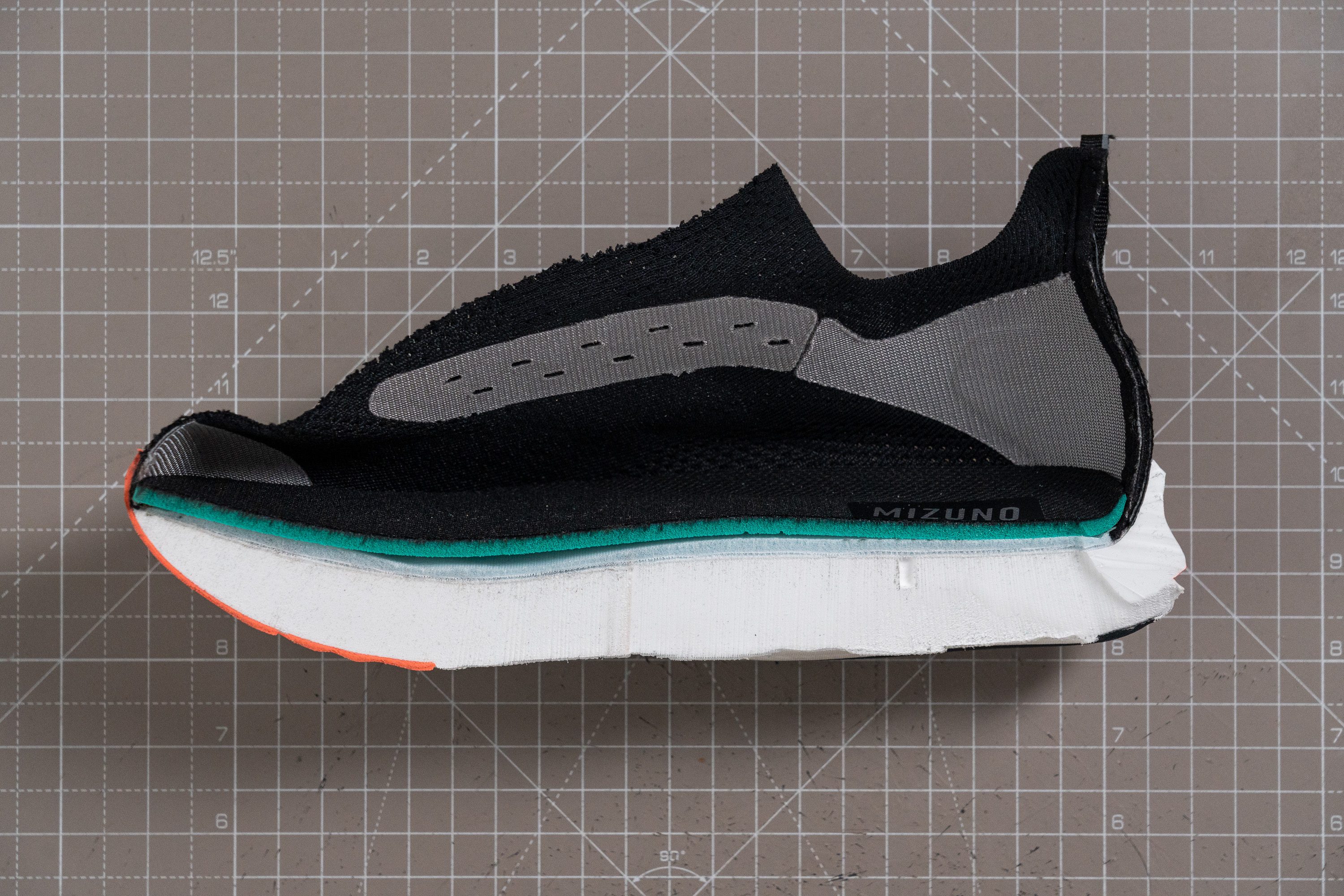
| Neo Zen | 7.0 mm |
| Media | 8.6 mm |
Suavidad de la mediasuela
En los últimos años, Mizuno ha sacado modelos que se han vuelto muy populares, como las Neo Vista, utilizando diseños atrevidos y espumas de última generación; y una parte importante de ese éxito se la debe a la espuma Enerzy NXT.
Esta espuma es muy blandita, y nuestro durómetro lo confirmó marcando 13,5 HA cuando la analizamos. Esto hace que las Neo Zen estén entre las zapatillas de entrenamiento diario más mullidas del mercado y, aunque a los corredores que necesitan una estabilidad extra les pueden parecer demasiado blanditas, Mizuno ha conseguido evitar que se chafen utilizando un montón de espuma, como ya mencionamos antes.
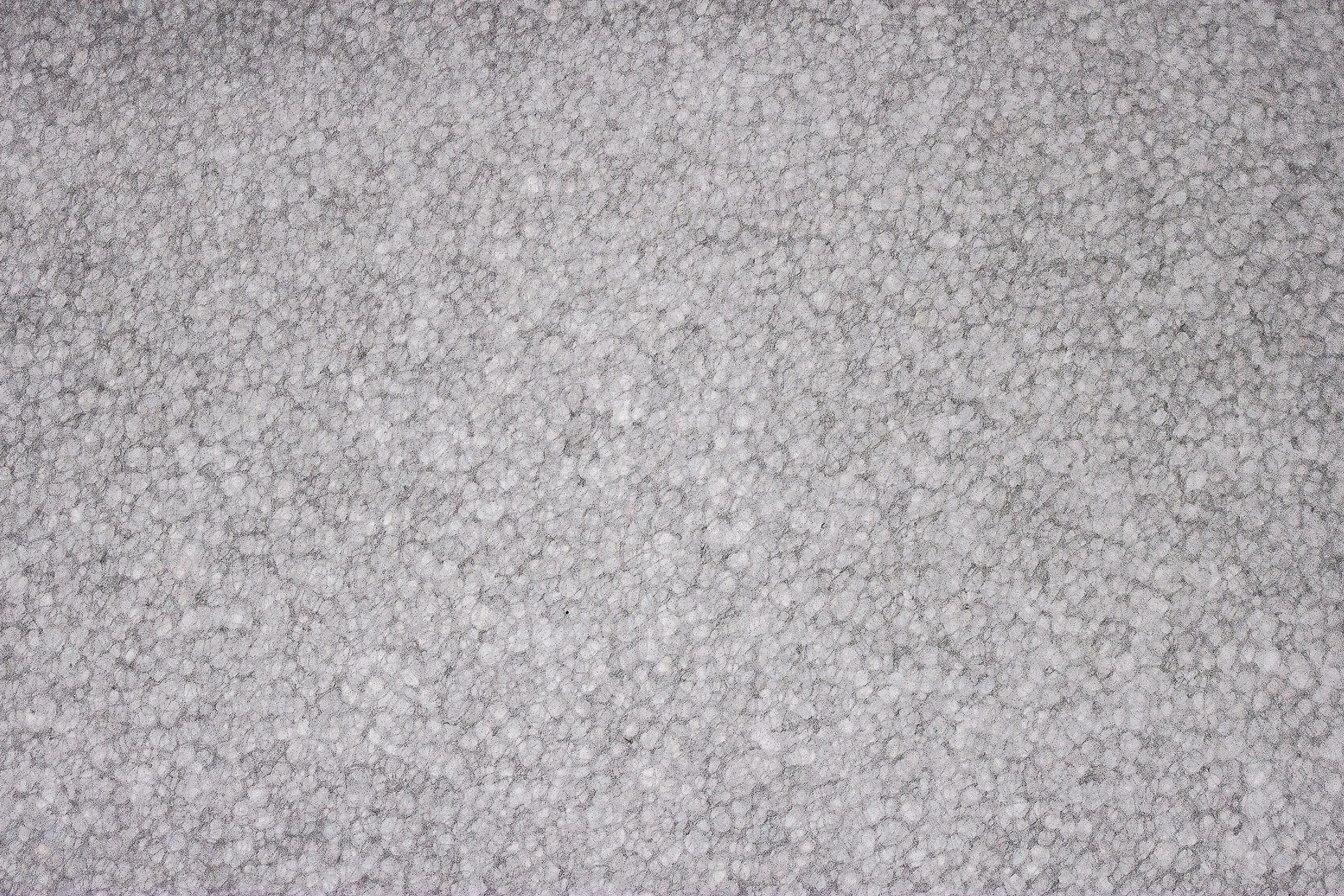
Y ya ha habido debates sobre qué se ha utilizado para hacer esta mediasuela. Cuando cortamos las zapatillas por la mitad, recortamos un cacho de espuma y lo analizamos bajo el microscopio. Los resultados fueron claros: es un TPU supercrítico inflado con nitrógeno, con burbujas más juntitas y pequeñas de lo habitual.
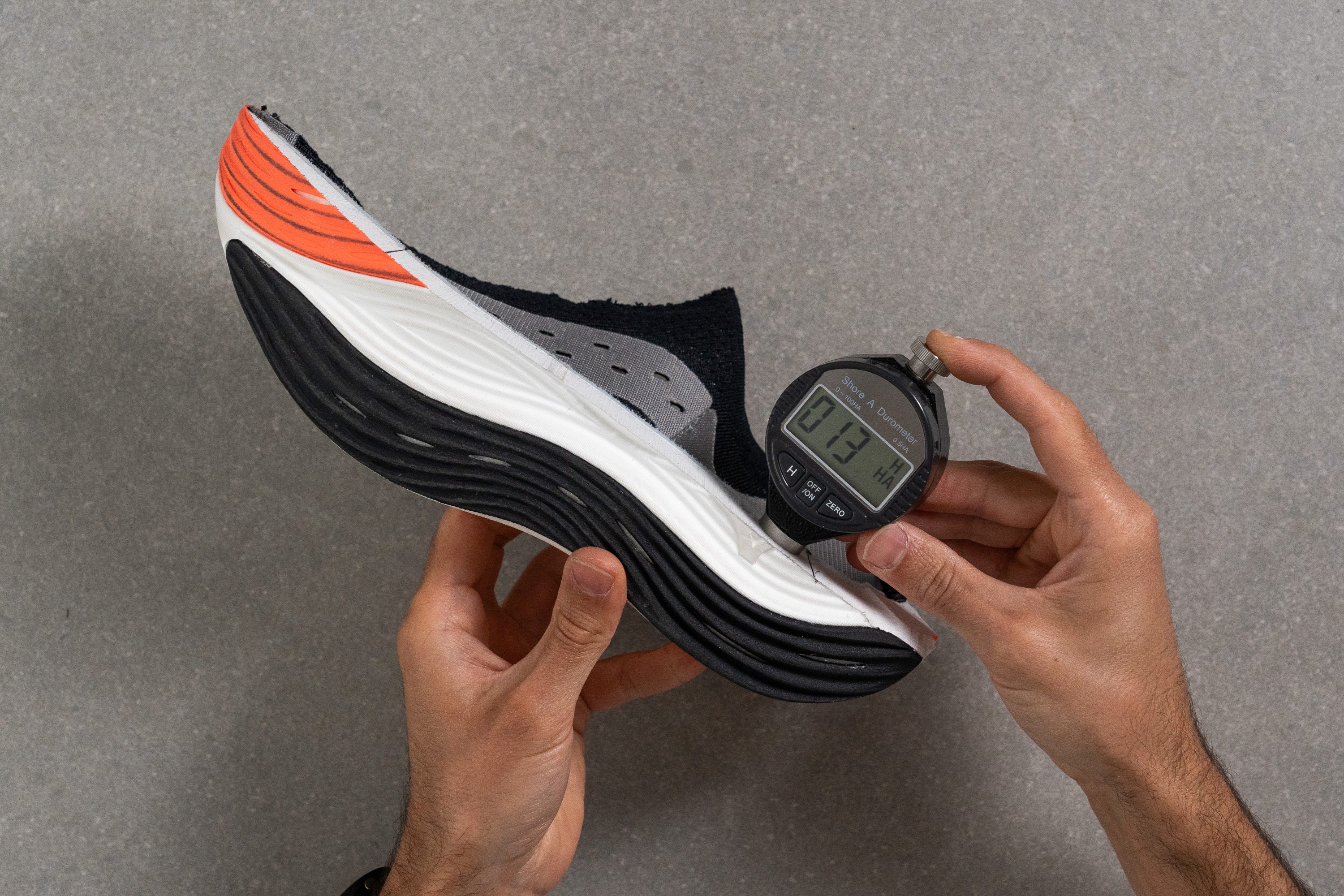
| Neo Zen | 13.5 HA |
| Media | 20.4 HA |
Rocker
Aunque su mediasuela es grandota, las Neo Zen tienen un rocker bastante suave para lo que solemos ver últimamente. Esto hace que sean más adecuadas para los corredores a los que no les gustan los rockers agresivos para correr. La curvatura del talón también es sutil, lo que respalda nuestra opinión de que, aunque son unas zapatillas que se adaptan a la mayoría de los atletas, son ideales para los corredores de mediopié.
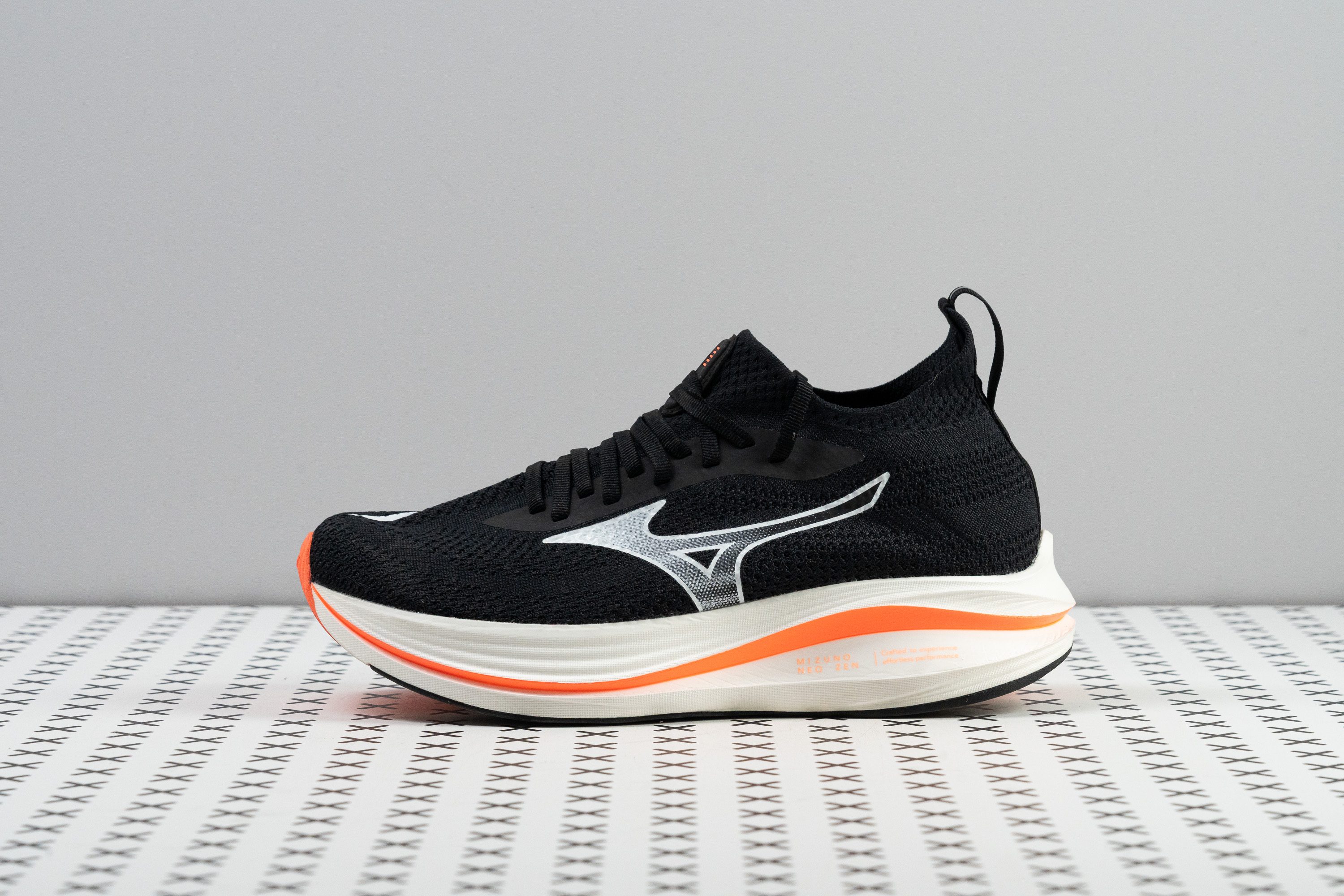
Pero, ¿por qué pueden tener un rocker menos agresivo que otras zapatillas modernas? Pues por dos razones: son más flexibles y esa espuma tan blandita que tienen se dobla haciendo muy poquita fuerza.
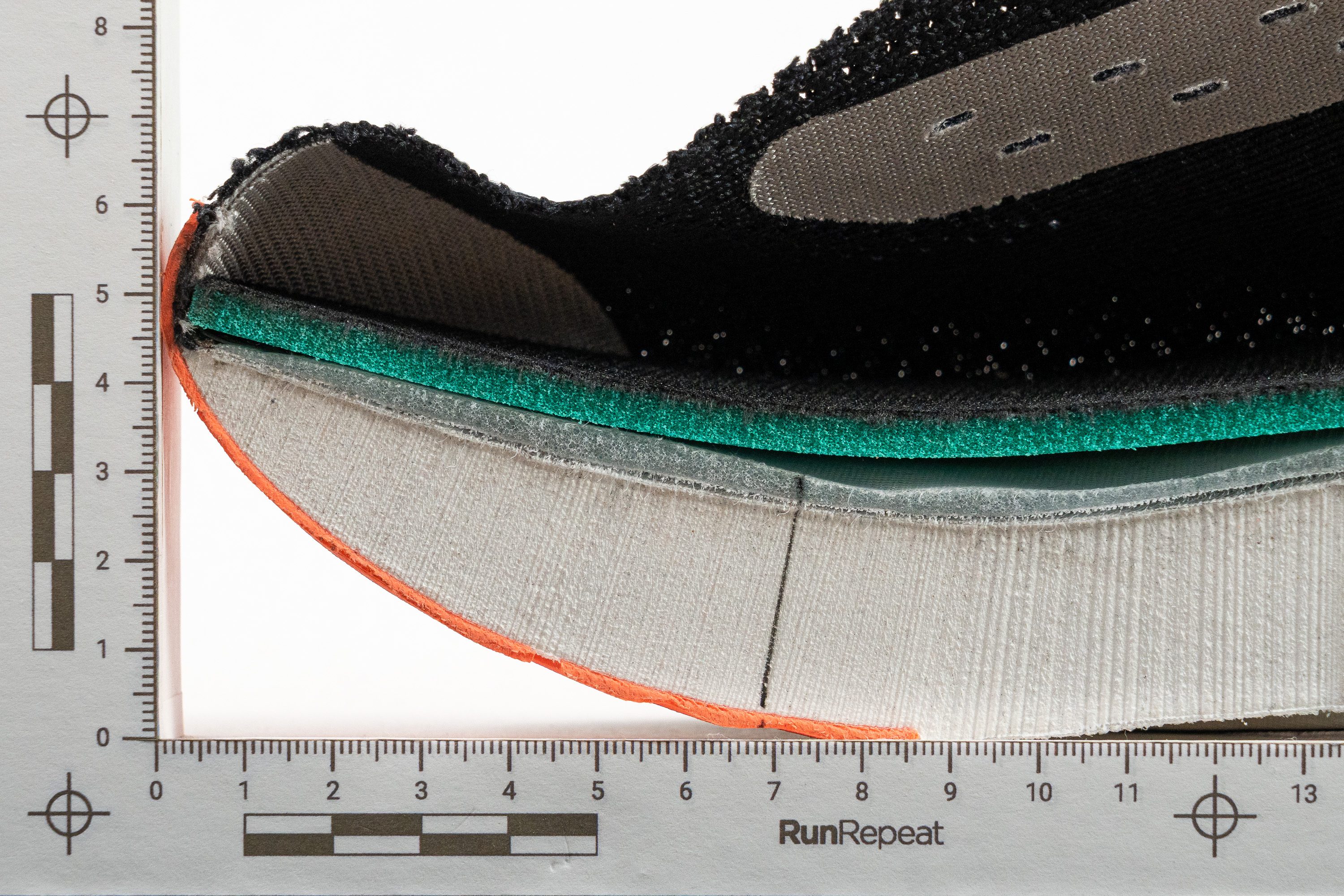
Tallaje y ajuste
Talla
Las Mizuno Neo Zen tallan bien (84 votos).
Anchura / Ajuste
Los uppers de knit pueden ser un poco engañosos cuando se trata de ajuste, ya que el material es más elástico que la malla, así que a veces se sienten más espaciosos de lo que indican nuestras mediciones de laboratorio. ¡Y eso es justo lo que pasa con las Neo Zen!
Este material suave y flexible es mucho menos rígido que la malla, adaptándose perfectamente a la forma del pie. Por eso, aunque nuestro calibre marcó solo 93,7 mm cuando medimos su punto más ancho, estas Mizuno se sienten como unas zapatillas de entrenamiento diario estándar con un ajuste medio y cómodo, no nos parecieron demasiado apreciadas.
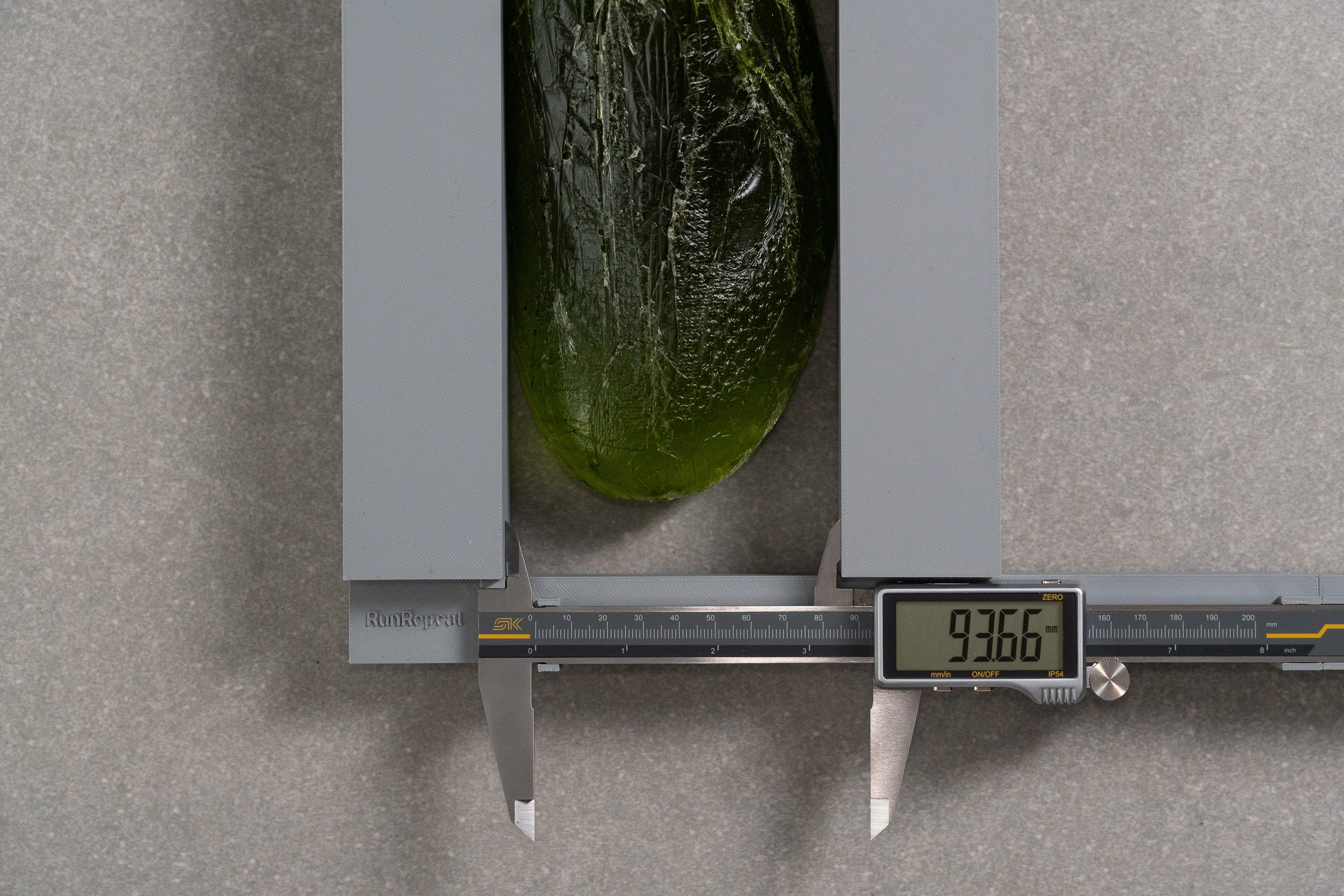
| Neo Zen | 93.7 mm |
| Media | 95.1 mm |
Anchura de la parte delantera
En cuanto a la anchura de la parte delantera, las Neo Zen se mantienen fieles a su ajuste parecido al de las zapatillas de entrenamiento diario. Sus 73,4 mm coinciden con la anchura media de la parte delantera de las zapatillas para correr por asfalto.
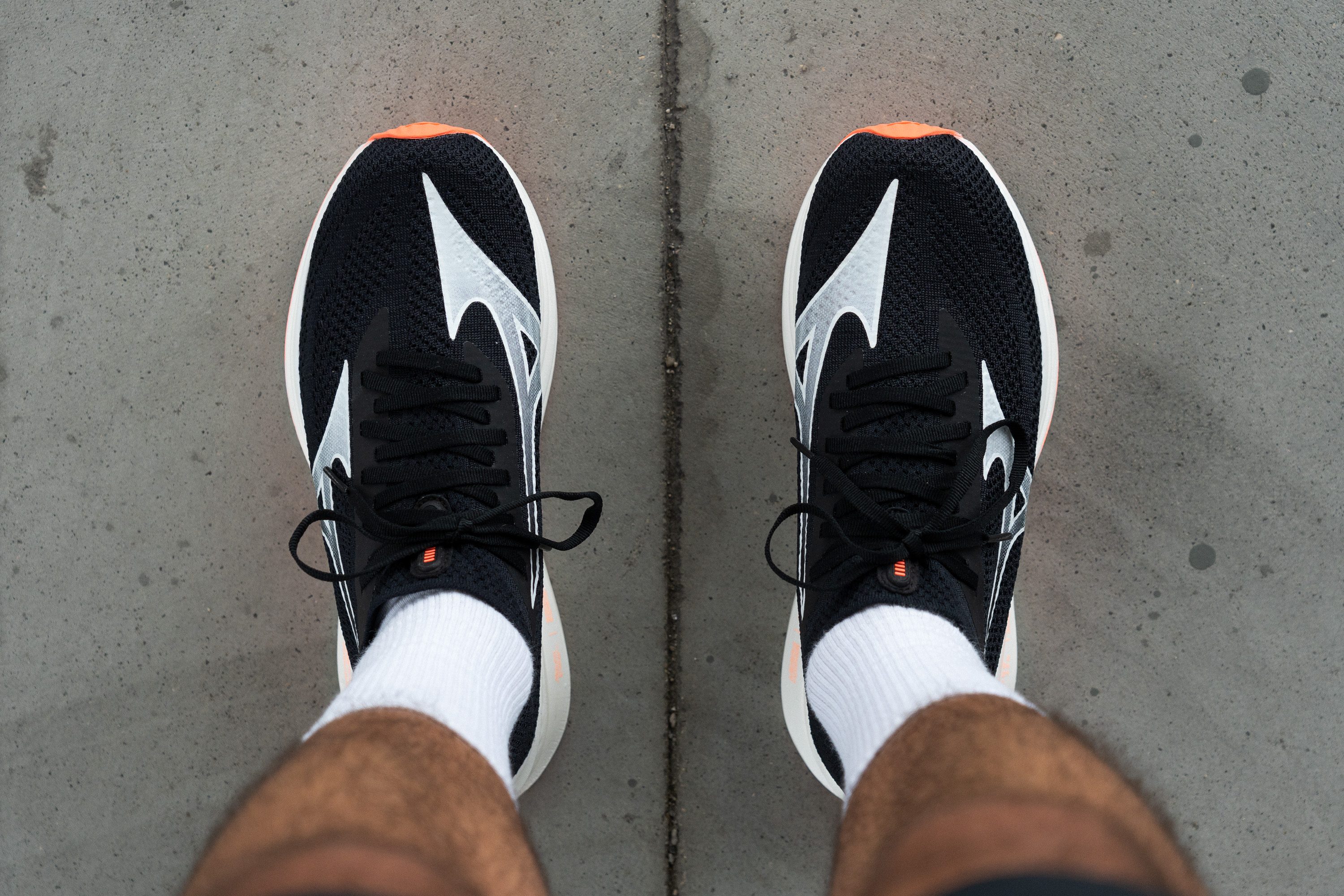
Eso sí, no te olvides de que, como tienen un upper de knit, dejan un poco más de espacio para que separes los dedos, ya que el material no restringe demasiado el movimiento.
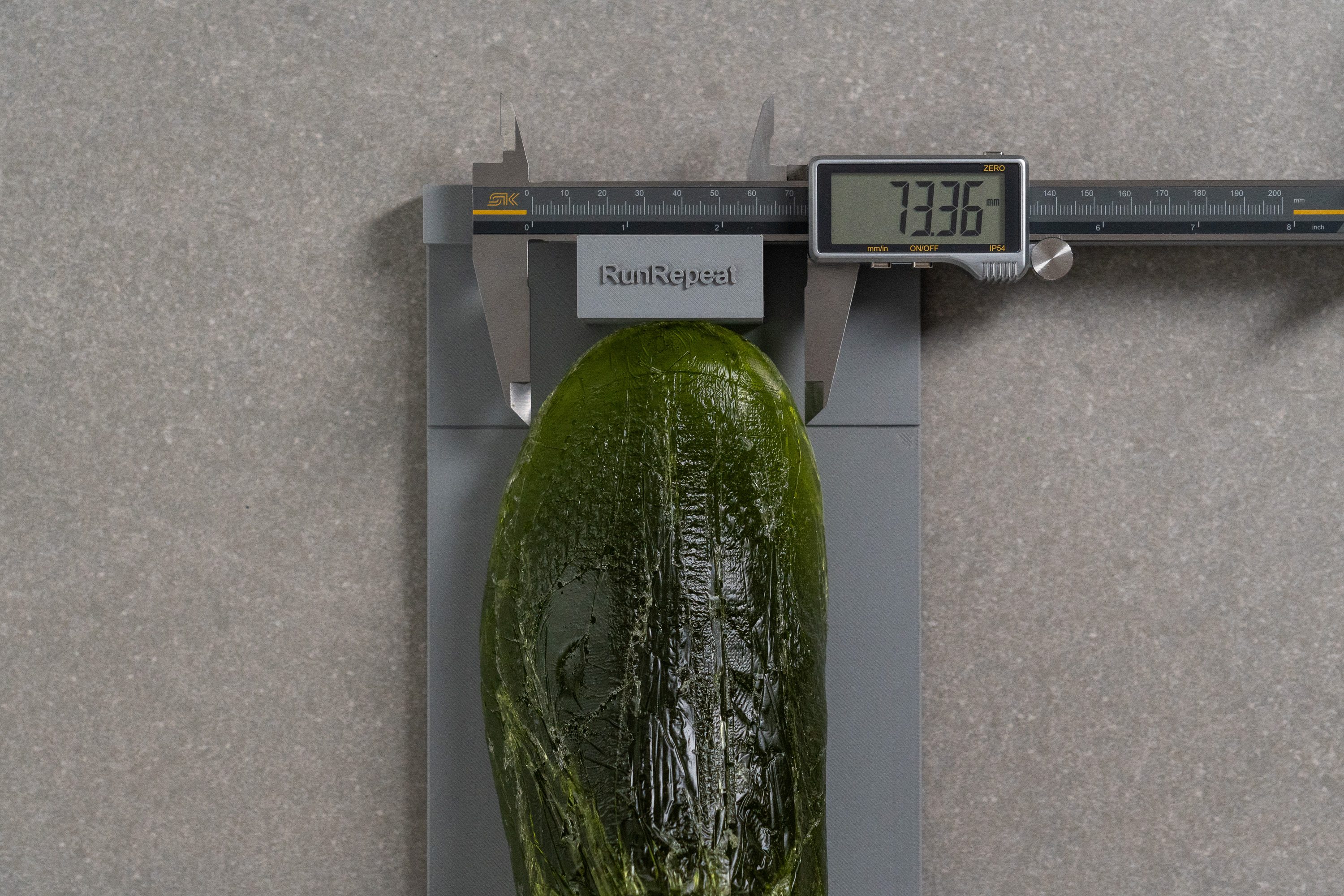
| Neo Zen | 73.4 mm |
| Media | 73.3 mm |
Altura de la parte delantera
Cuando nos pusimos las Neo Zen, descubrimos que ofrecían mucho espacio para los dedos: sin molestias ni zonas que nos apretasen demasiado; ofrecen un ajuste sin complicaciones ni presiones desde el minuto uno.
Cuando medimos la altura de la parte delantera, nuestro calibre marcó 27,0 mm, ofreciendo un ajuste espacioso que debería ser ideal incluso para los corredores sensibles a la presión.
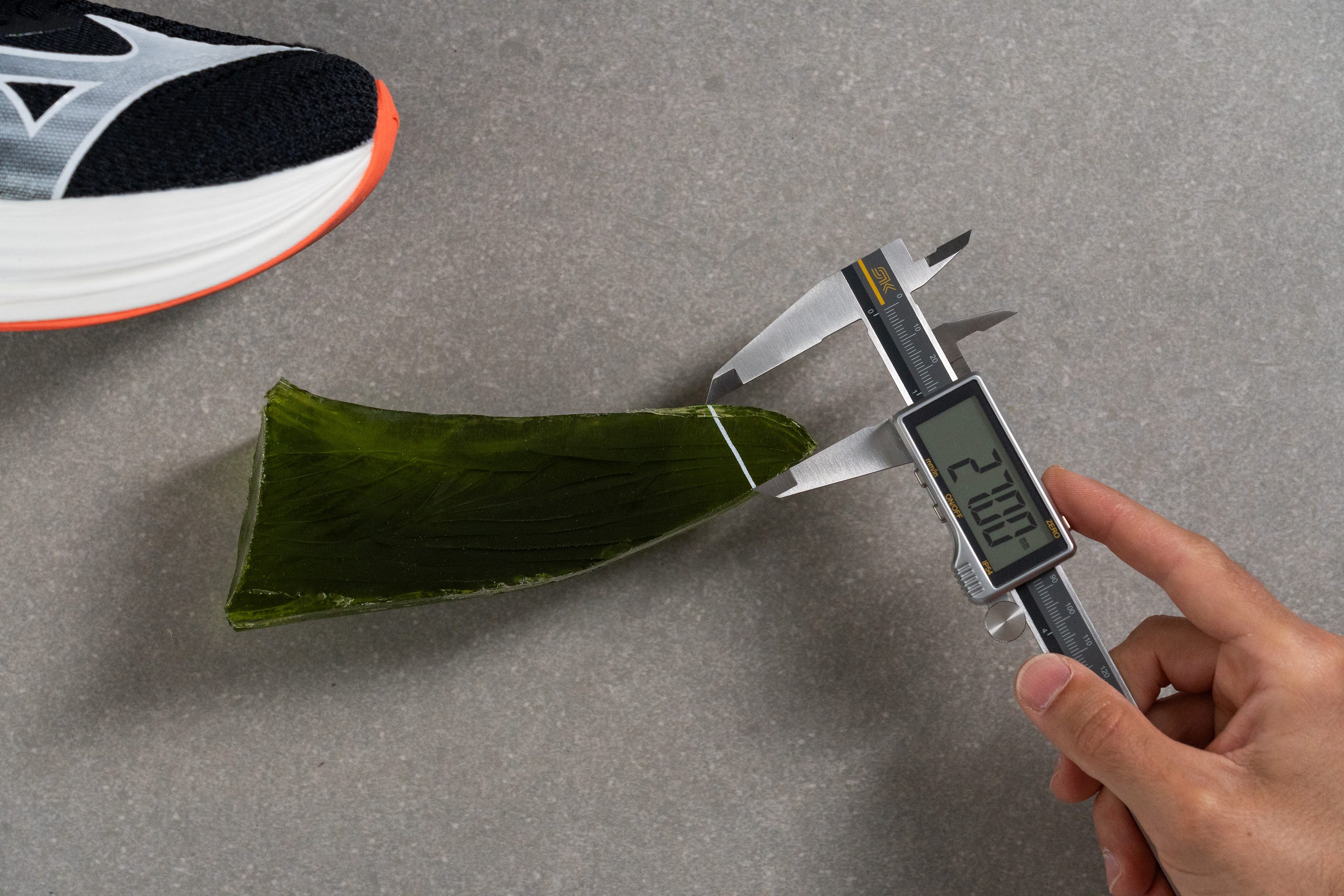
| Neo Zen | 27.0 mm |
| Media | 27.1 mm |
Tracción / Agarre
Traction test
Gracias a nuestra máquina de tracción, descubrimos que las Neo Zen no son las mejores de su categoría, pero su rendimiento es decente.
Se llevaron un 0,38, que no está mal para unas zapatillas con tanta mediasuela expuesta. Ofrecen un agarre sólido en los suelos que están secos, y en los días de lluvia aguantan bien si sales a correr de manera ocasional un par de veces. Sin embargo, si te suele tocar lidiar con asfalto resbaladizo, creemos que las ASICS Gel Nimbus 27 son una mejor opción.
| Neo Zen | 0.38 |
| Media | 0.48 |
Diseño de la suela exterior
La suela exterior de las Neo Zen siguen la última moda en Mizuno, así que se parecen mucho a las Neo Vista, que han conseguido un buen club de fans este último año.
Un corte que tienen en el centro deja expuesta bastante espuma. Esto ayuda a que las zapatillas sean ligeras como una pluma, pero también limita su agarre en las superficies mojadas, reduciendo la durabilidad en terrenos accidentados o rocosos.
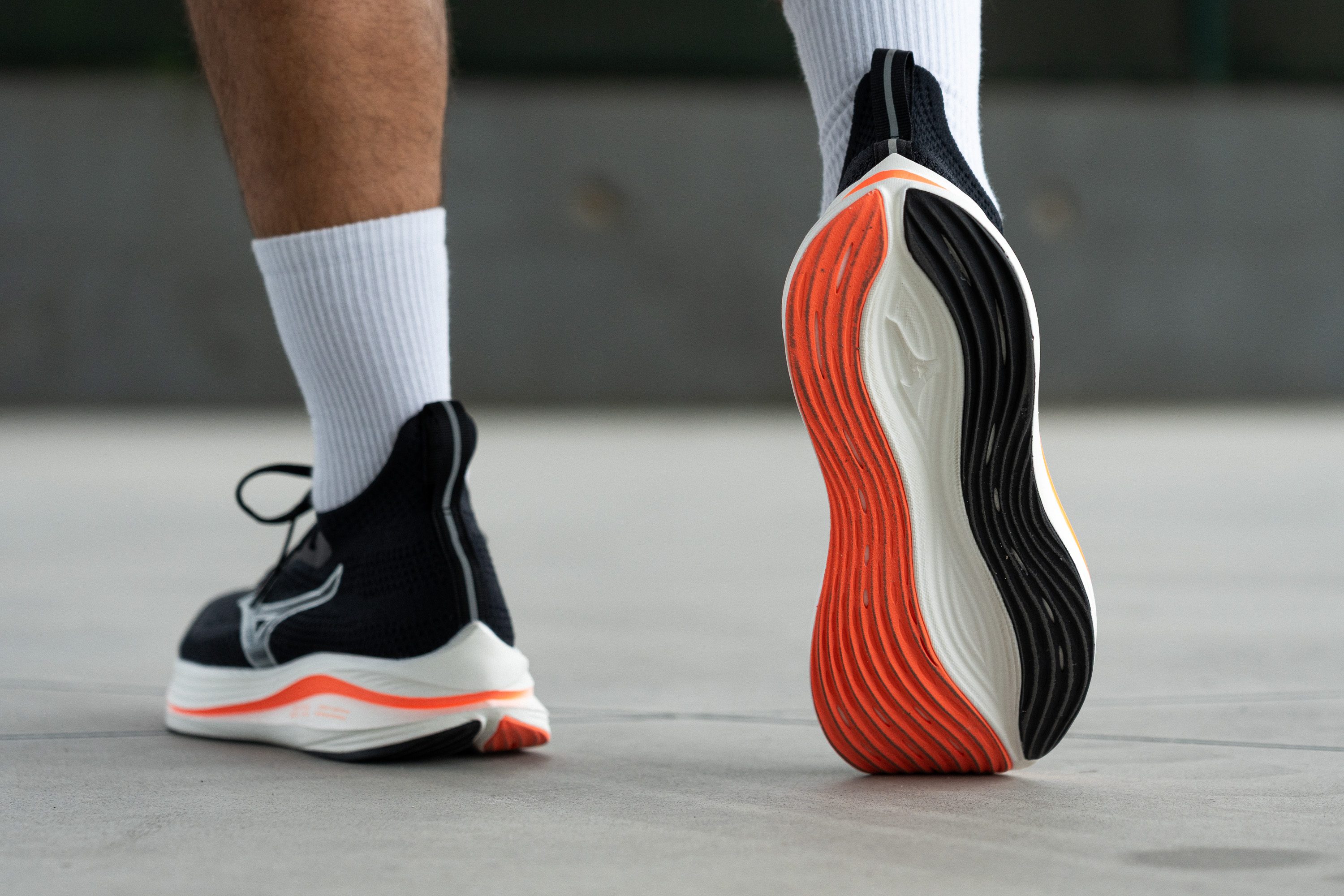
Flexibilidad / Rigidez
Como las Neo Zen ofrecen una mezcla estupenda entre una suela alta y una estructura flexible, teníamos ganas de ver cómo rendían en esta prueba. Necesitamos 12,8 N para doblarlas, lo que hace que sean perfectas para los corredores que están buscando unas zapatillas cómodas y flexibles para las carreras largas y relajadas.

| Neo Zen | 12.8N |
| Media | 15.3N |
Peso
La espuma Enerzy NXT se siente estupenda bajo los pies, ya que es blandita y ofrece rebote, pero eso no es todo..., ¡también es muy ligera! Solo así podemos explicar cómo unas gigantonas como estas pesan solo 234 g.
En nuestra opinión, esta es una de las mejores características que tienen las Neo Zen, ya que ofrecen una combinación muy poco común de una amortiguación respetuosa con las articulaciones y una estructura ligera como una pluma que es difícil de encontrar en otras zapatillas con una suela así de alta.
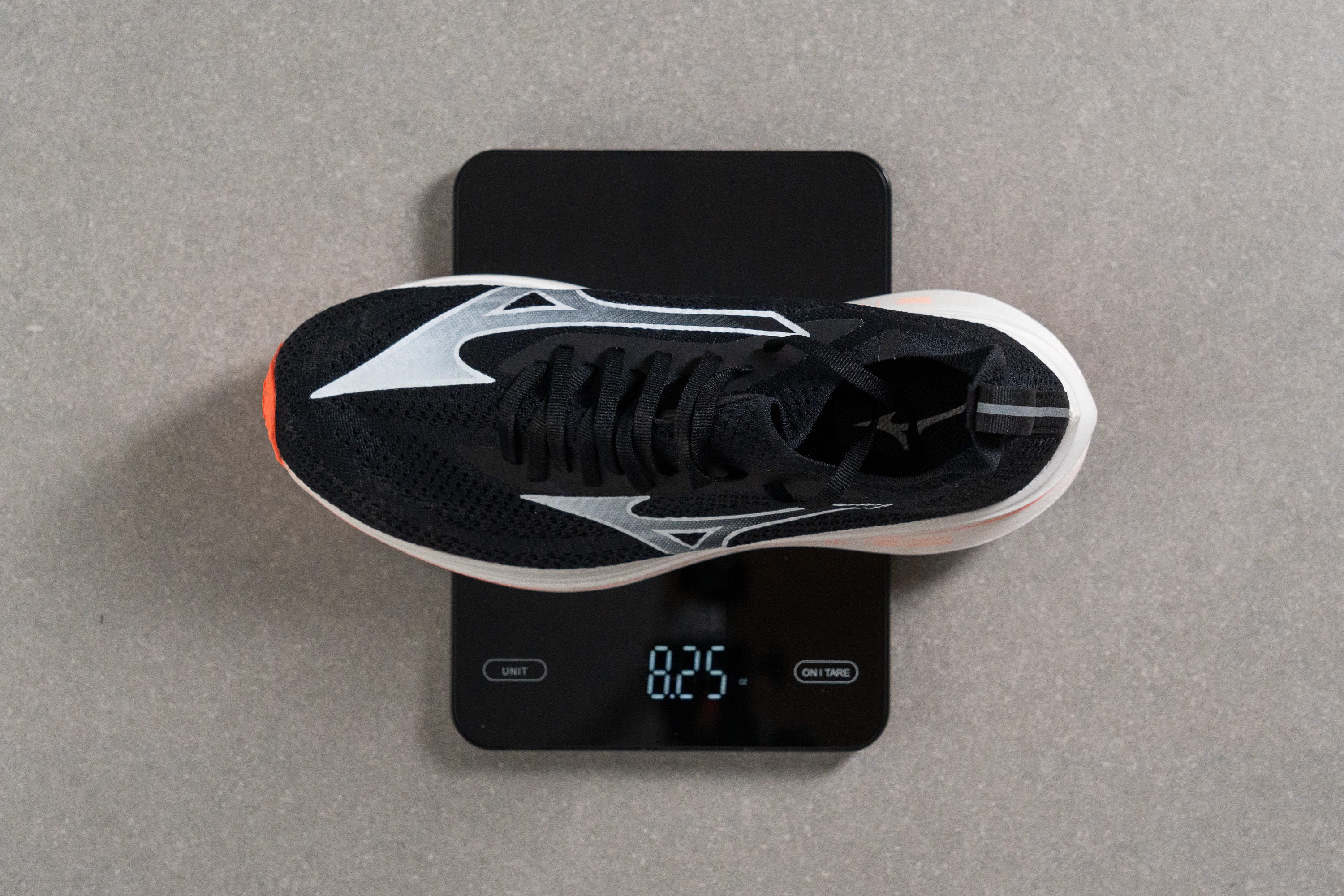
| Neo Zen | 8.3 oz (234g) |
| Media | 9.3 oz (264g) |
Transpirabilidad
Una de las desventajas habituales de los uppers de knit es que son muy poco transpirables. Este material suele ser más gordito y no dejar que el aire pase fácilmente, por lo que no suele ser la mejor opción para correr en verano.
Pero, en el caso de las Neo Zen, Mizuno adoptó un enfoque más inteligente. Creemos que la marca ha creado un upper ideal para todo el año que evita los típicos problemas del knit y, en nuestra prueba de transpirabilidad, se llevó un sólido 4/5.
El secreto está en los agujeritos redondos para el flujo de aire que tienen en la zona de los dedos. En cuanto acercamos las zapatillas a una luz, se iluminaron con claridad.
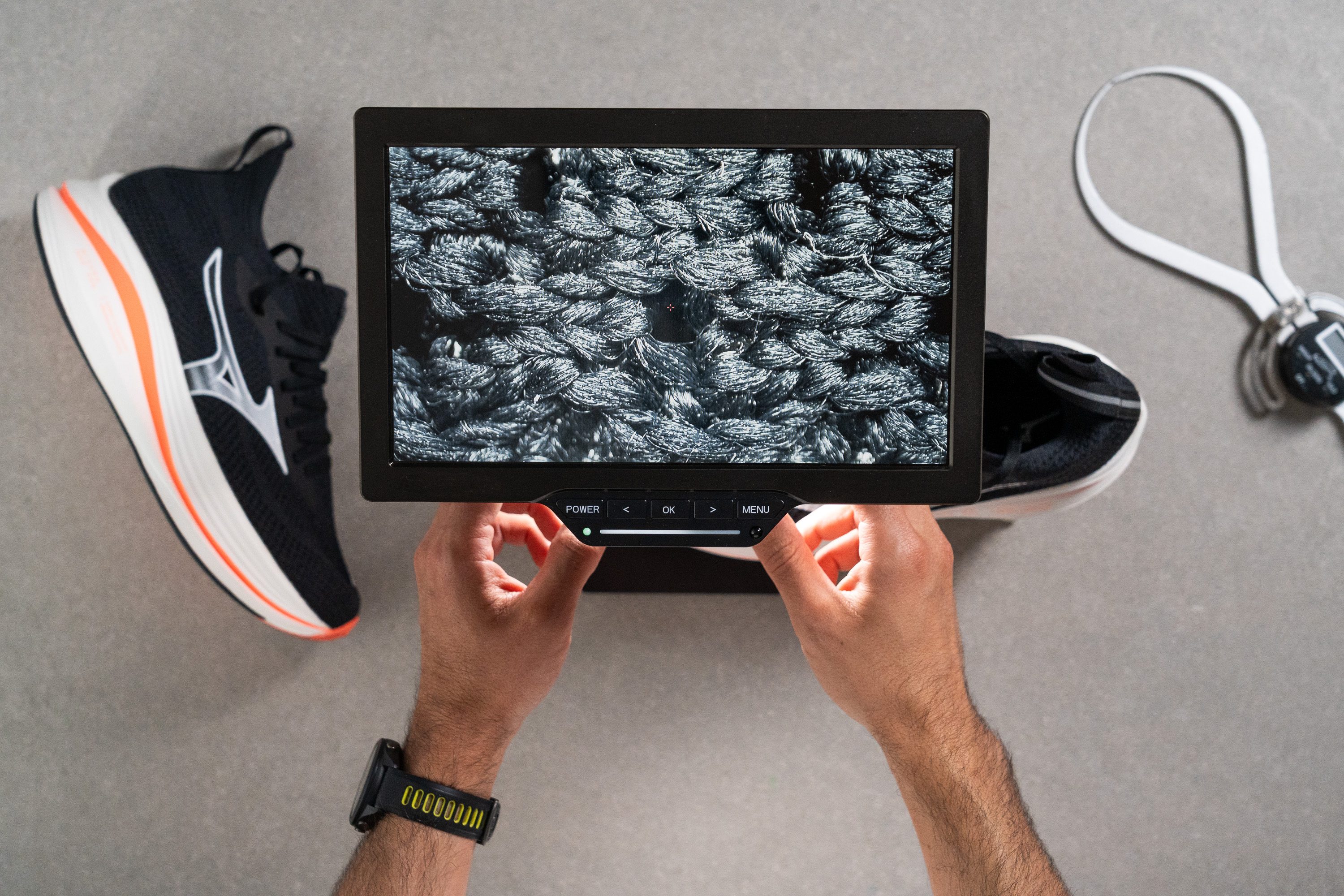
Para saber más sobre esto, cogimos nuestro microscopio y analizamos el material más de cerca.
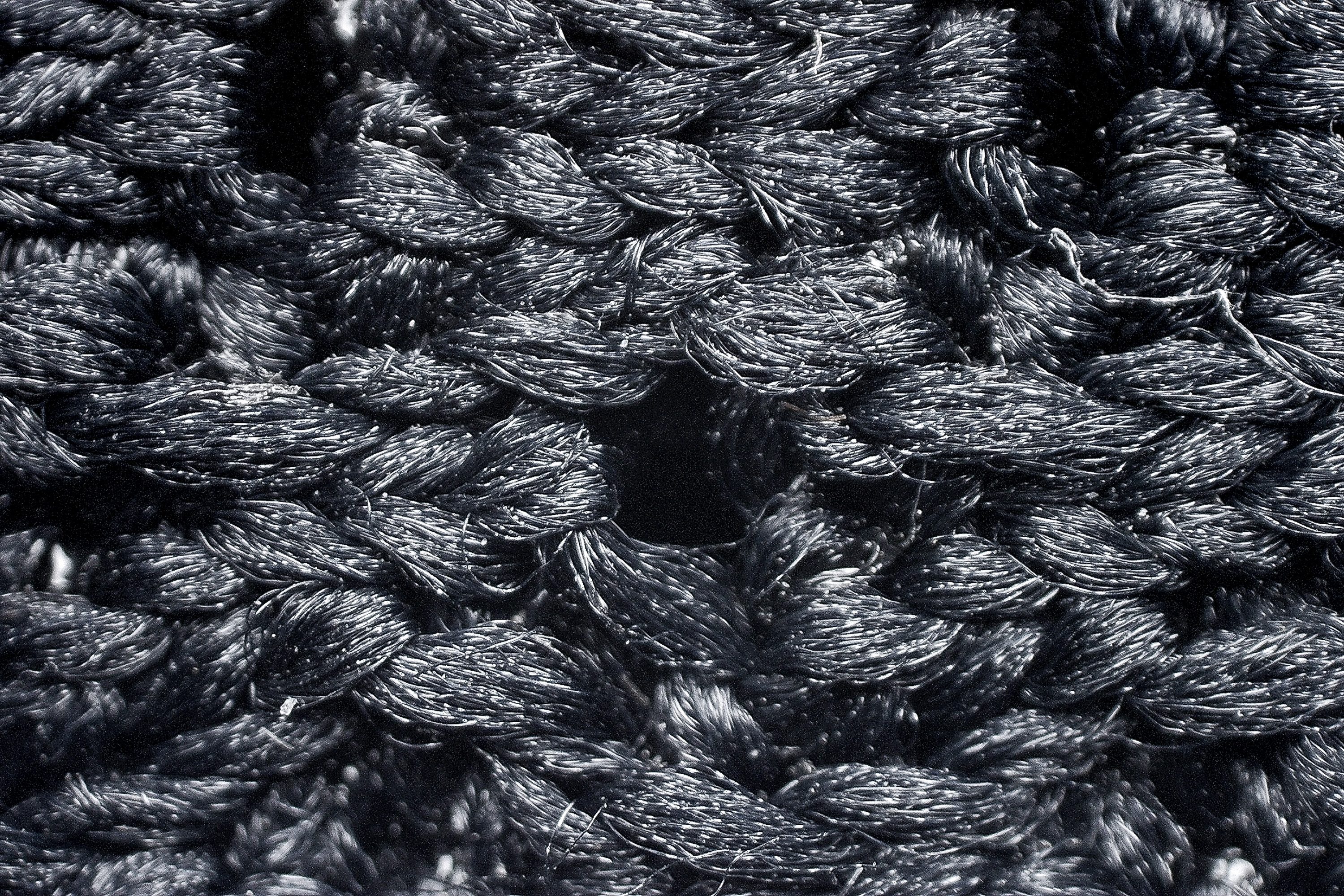
Lo que vimos fue un material tupido con bastantes aperturas. Los agujeritos parecían un poquito más pequeños de lo que nos esperábamos, pero no hay una segunda capa por detrás que no deje que el aire salga tranquilamente (que es lo que suele pasar con la mayor parte de los uppers de malla con doble capa).
Sin embargo, si te esperas un upper muy acolchado y lleno de espuma... terminarás decepcionado. Como Mizuno ha intentado hacer que este modelo sea ligerísimo, no ha utilizado nada de acolchado extra.
| Neo Zen | 4 |
| Media | 3.7 |
Estabilidad
Prueba de estabilidad lateral
Mientras que algunos de los modelos de entrenamiento diario que han salido últimamente son muy estables, las Neo Zen... no. Su espuma blandita y su suela alta hacen que la estabilidad esté un poco fuera de su alcance.
Pero bueno, de todos modos, consiguen ser razonablemente estables para los corredores neutros gracias tanto a la plataforma ancha de su talón como al largo corte central de la suela exterior.
Rigidez torsional
Como se han llevado un 3/5, no podemos decir que estas zapatillas son rígidas. De hecho, son una de las opciones más flexibles que hemos analizado dentro de la categoría maximalista, ya que su suela es enorme.
| Neo Zen | 3 |
| Media | 3.5 |
Rigidez del contrafuerte del talón
Otra señal de que Mizuno no ha priorizado la estabilidad en las Neo Zen es la rigidez del contrafuerte del talón, que se ha llevado un 1/5. Es muy flexible, así que a lo mejor es demasiado inestable para los talones que necesitan un extra de sujeción.
Por otro lado, es muy cómodo para los demás corredores, ya que envuelve suavemente el talón sin presionar el tendón de Aquiles.
| Neo Zen | 1 |
| Media | 2.9 |
Anchura de la mediasuela - antepié
Otra razón importante por la que estas zapatillas no son muy estables es la anchura de su mediasuela. Diferenciándose de sus competidoras, Mizuno optó por utilizar un diseño más aerodinámico para evitar que se sintiesen toscas: nuestro calibre marcó solo 113,5 mm en el antepié.
Es un resultado más bajo que la media, rompiendo con la tendencia actual de los modelos anchísimos, y la verdad es que ha sido una sorpresa agradable. El mercado ya está lleno de zapatillas demasiado anchas, y es genial tener opciones distintas entre las que elegir.

| Neo Zen | 113.5 mm |
| Media | 114.4 mm |
Anchura de la mediasuela - talón
El talón es un poquito más ancho que la media, probablemente para compensar la menor estabilidad de la espuma blandita y el flexible contrafuerte del talón. Incluso así, no es nada ni extremo ni molesto, y apenas se nota al correr.
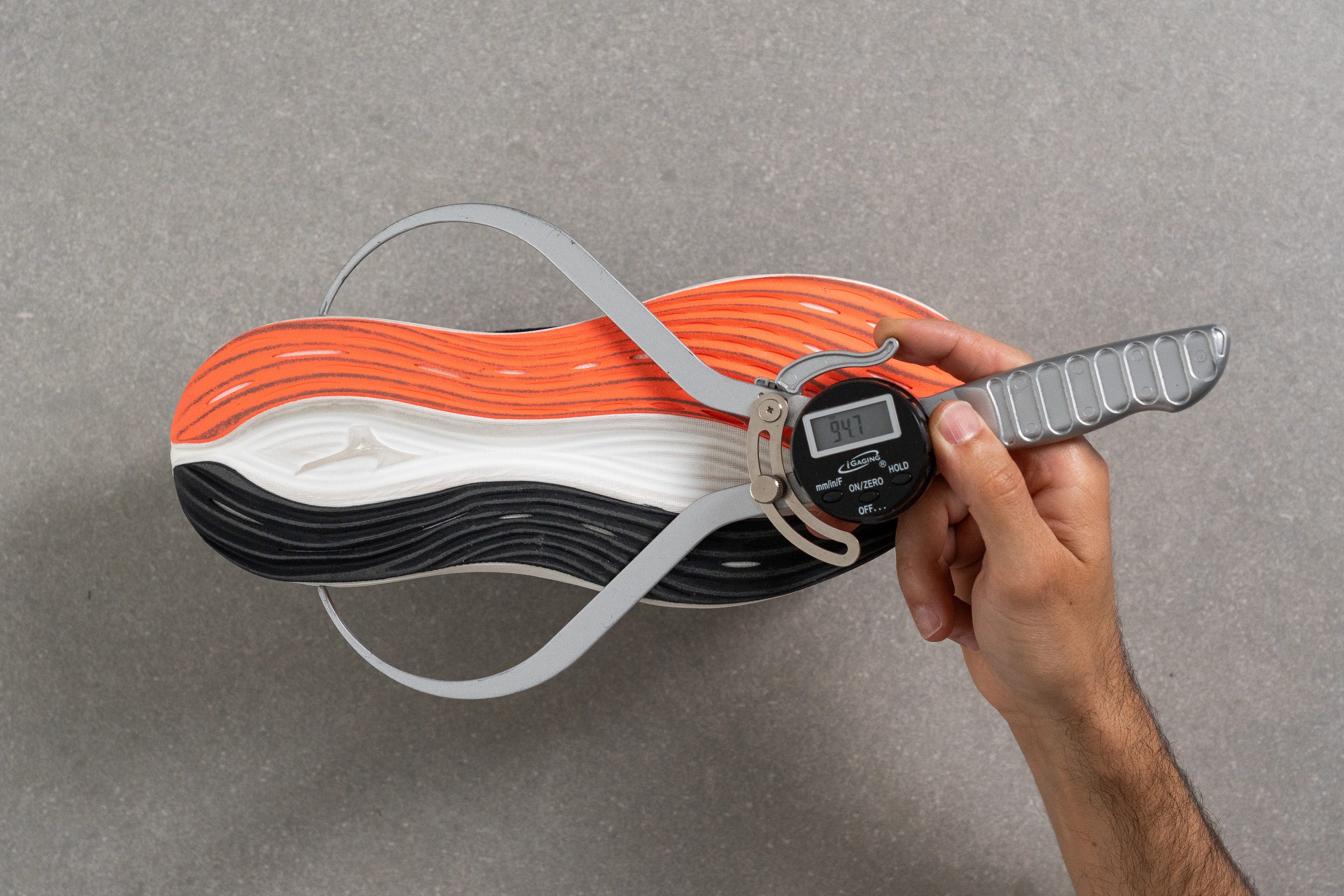
| Neo Zen | 94.7 mm |
| Media | 90.7 mm |
Durabilidad
Durabilidad de la parte delantera
El upper de knit de las Neo Zen ofrece una transpirabilidad sólida, pero lo que nos ha sorprendido incluso más es lo resistente que es a la abrasión. En nuestra prueba Dremel, se llevó un 5/5 perfecto, lo que hace que sean una opción destacada dentro de su rango de precios.
| Neo Zen | 5 |
| Media | 2.6 |
Durabilidad del acolchado del talón
La zona del talón también aguantó bien, que es algo que nos esperábamos teniendo en cuenta el poco acolchado que tiene. No consiguió llevarse nuestra nota más alta, pero un 4/5 sigue siendo mejor que la media por mucho.
| Neo Zen | 4 |
| Media | 3.4 |
Durabilidad de la suela
El caucho X10 que utiliza Mizuno se llevó un resultado estupendo en nuestra prueba de durabilidad. Aunque es blandito, terminó con unos daños de solo 0,9 mm, que es algo que no solemos ver en las suelas exteriores con este tipo de compuesto.
| Neo Zen | 0.9 mm |
| Media | 1.1 mm |
Grosor de la suela
Con sus 2,7 mm, el equilibrio es sólido: es suficientemente ligera para reducir el peso, y suficientemente gruesa para soportar el uso habitual sin desgastarse demasiado rápido.
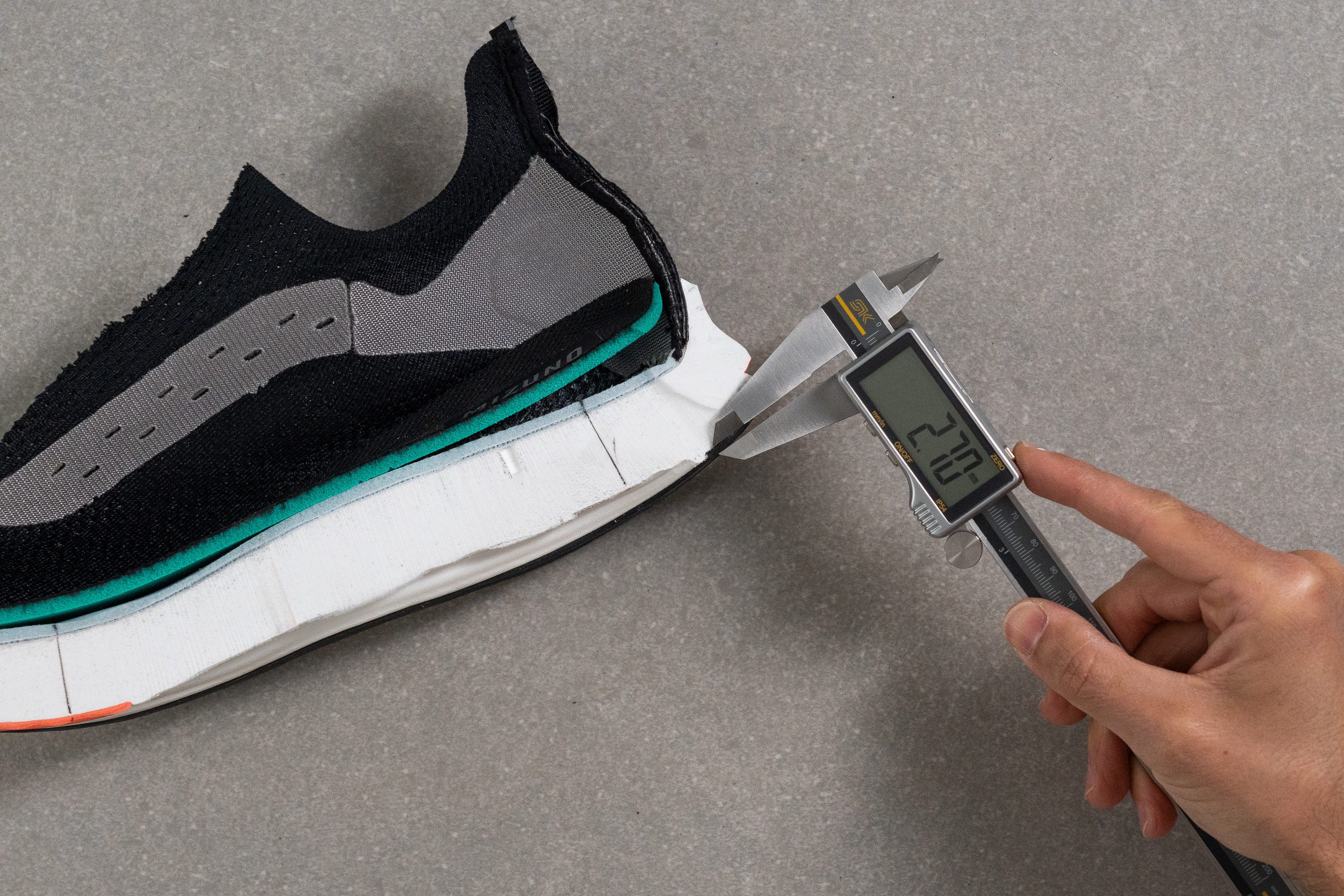
| Neo Zen | 2.7 mm |
| Media | 3.2 mm |
Varios
Grosor de la plantilla
Uno de los pocos elementos de las Neo Zen que no destacan es la plantilla: es bastante estándar tanto en material como en sensaciones, con un grosor medio de 4,8 mm.
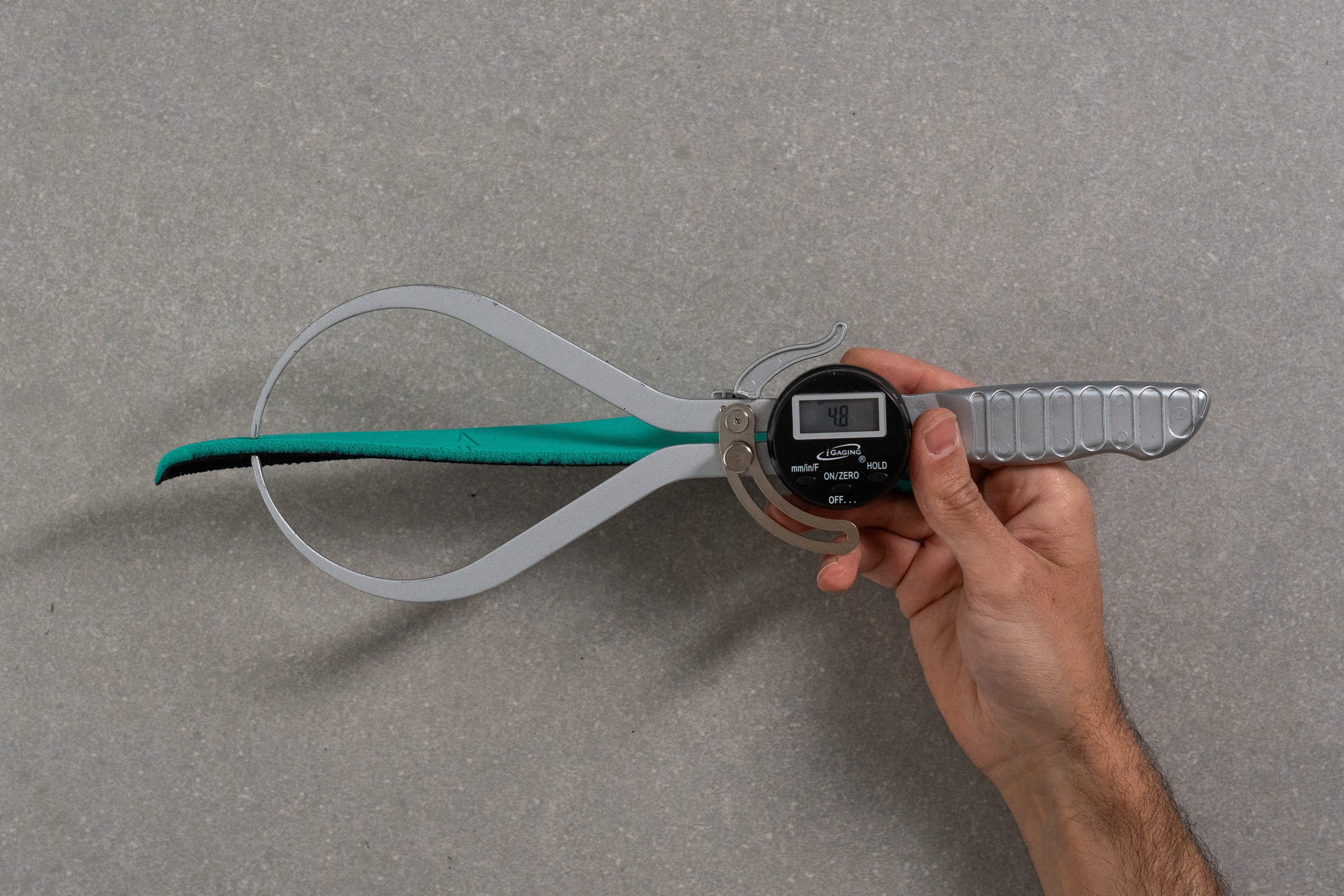
| Neo Zen | 4.8 mm |
| Media | 4.5 mm |
Plantilla extraíble
¿Quieres aumentar la amortiguación de las Neo Zen o reducirla un poco? Pues cambia su plantilla extraíble y utiliza una o más gordita o más blandita.
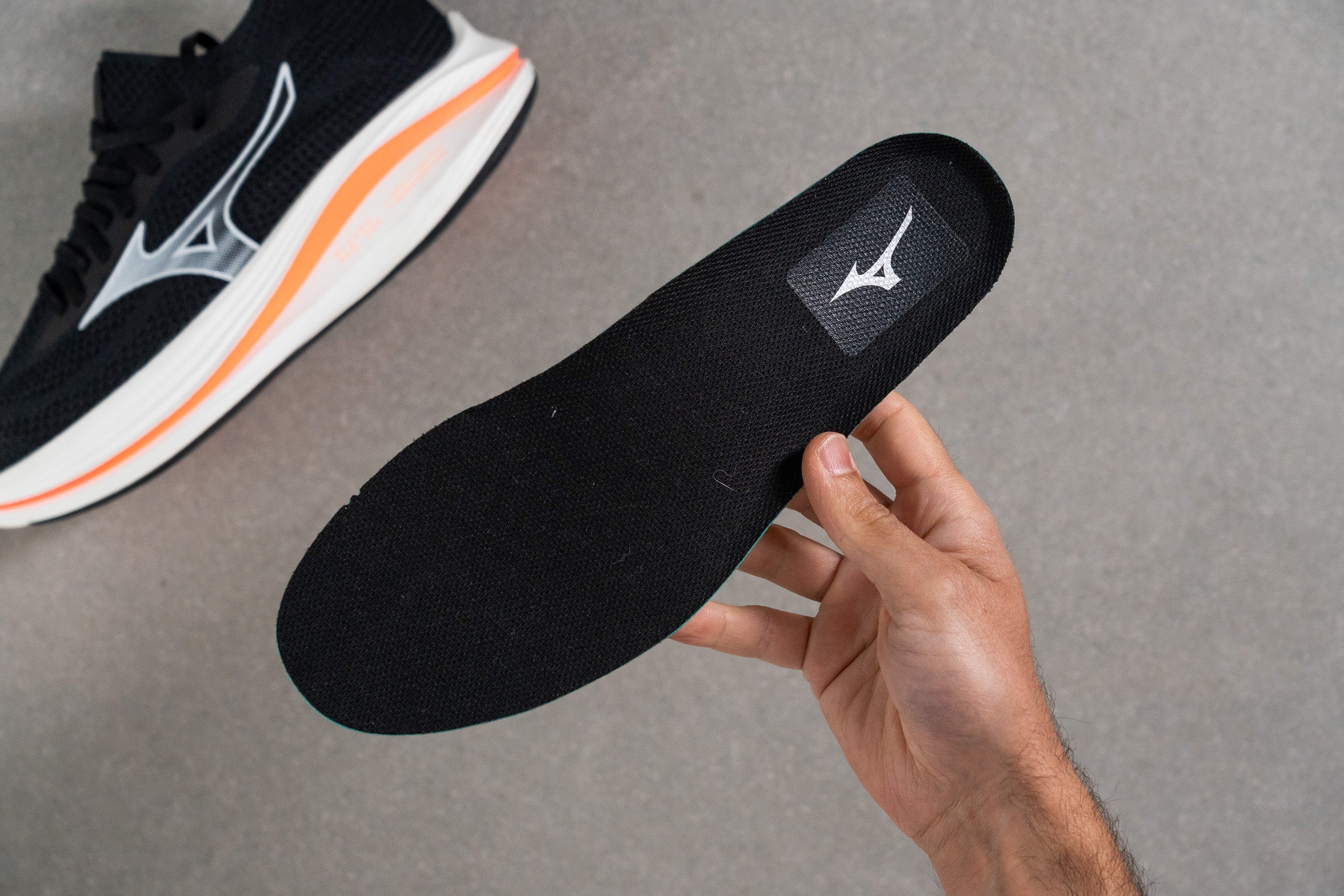
| Neo Zen | Sí |
Rigidez de la mediasuela en frío (%)
Mientras que la espuma PEBA no cambia mucho ni después de estar 20 minutos en nuestro congelador, las Neo Zen se volvieron un 33 % más rígidas, un resultado peor que la media. Si esto te preocupa, échale un vistazo a las ASICS Superblast 2, que están hechas con PEBA.
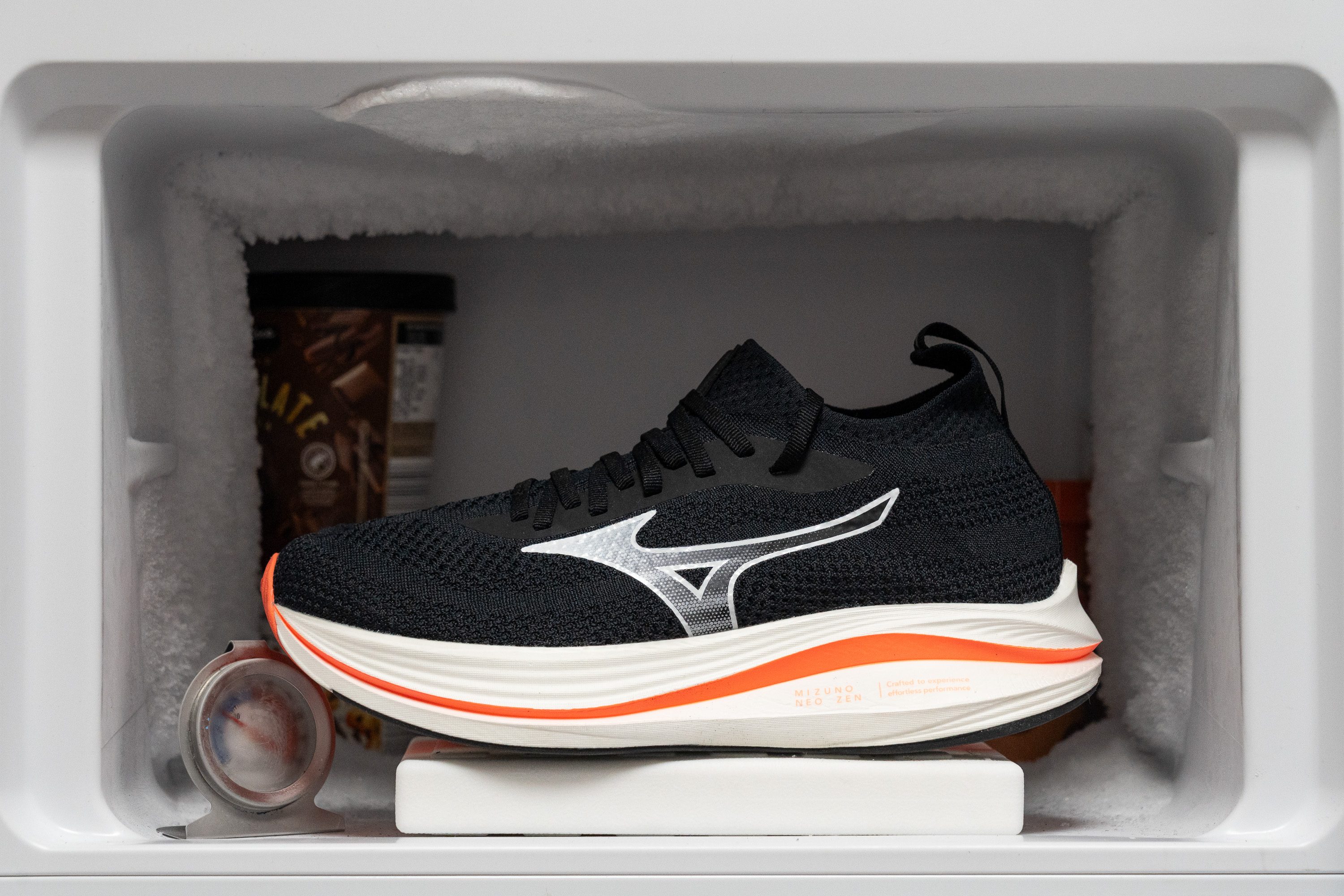
| Neo Zen | 33% |
| Media | 24% |
Elementos reflectantes
Mizuno ha conseguido una doble victoria en el diseño del talón al utilizar una tira reflectante que llega hasta el tirador del talón para ocultar las costuras.
| Neo Zen | Sí |
Acolchado de la lengüeta
La lengüeta integrada de las Neo Zen no está muy acolchada, ya que cuando medimos su grosor nos dio solo 4,1 mm. Por lo tanto, no sentirás que tienes una almohada en el empeine, pero a menos que seas extremadamente sensible a la presión en esa zona, no deberías tener problema ni en las carreras largas.
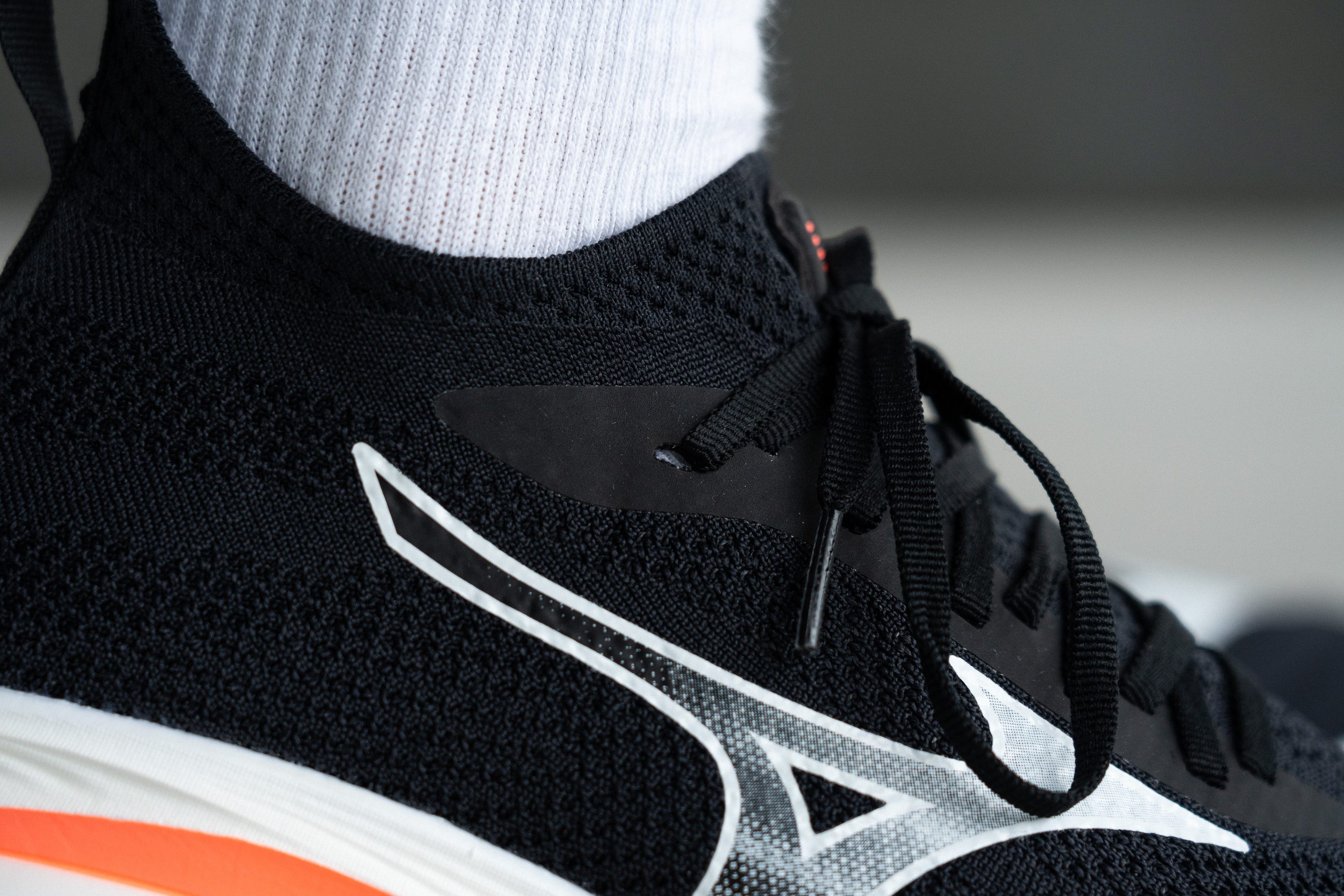
El diseño de los cordones destaca por ser minimalista y por no tener costuras, adaptándose al upper de una suela pieza. No hay un ojal extra en la parte de arriba para hacerse un nudo del corredor, pero la marca lo ha hecho aposta: esta estructura ajustada, parecida a un calcetín, ya sujeta el talón en su sitio de forma segura sin necesidad de refuerzos adicionales.
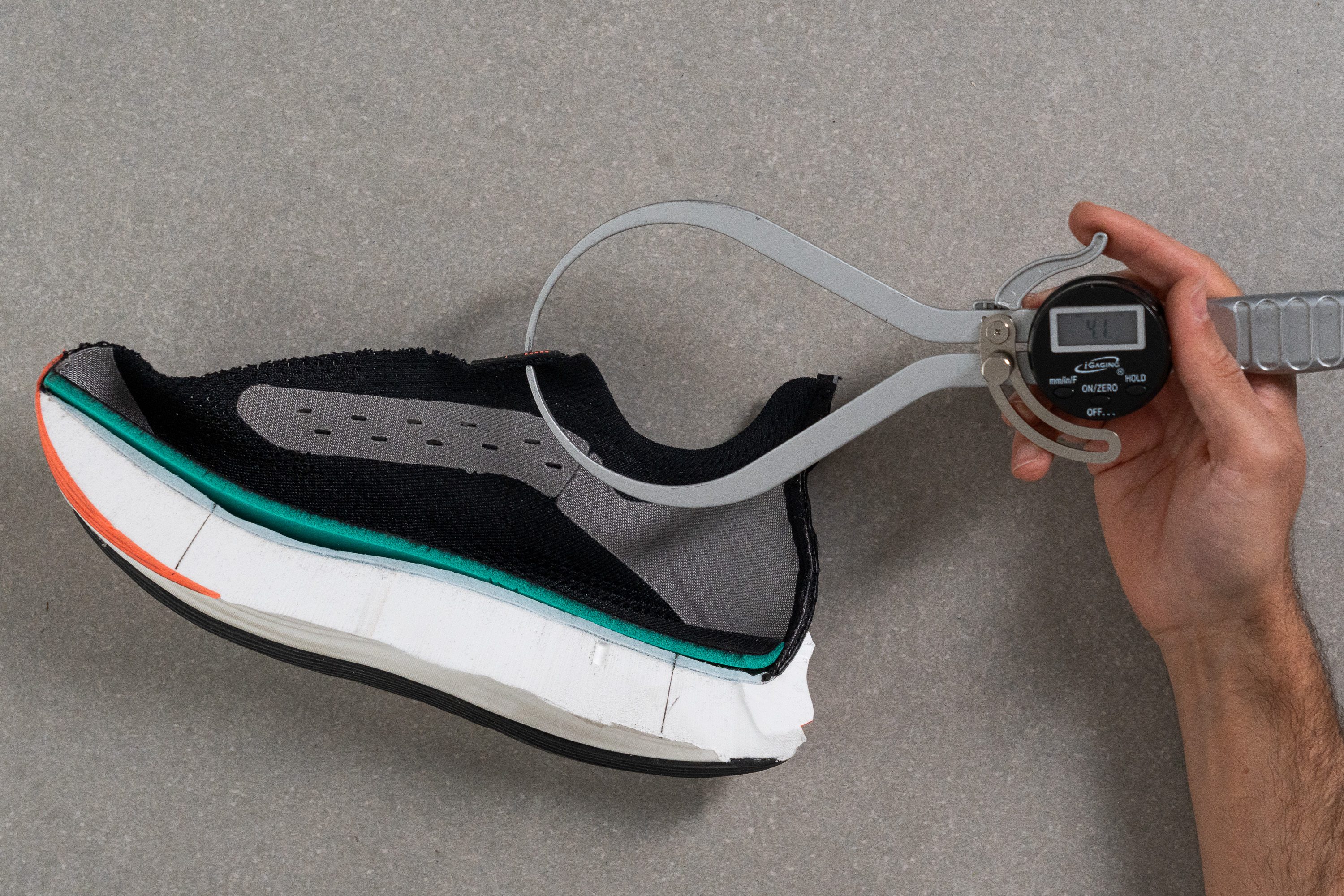
| Neo Zen | 4.1 mm |
| Media | 5.8 mm |
Lengüeta: tipo de refuerzo
El upper tipo calcetín envuelve el pie como si le diese un abrazo y elimina cualquier posibilidad de que la lengüeta baile, ya que tiene un diseño totalmente integrado. Personalmente, creemos que se parece al que hizo destacar a las Nike Alphafly 3 y a las generaciones anteriores.
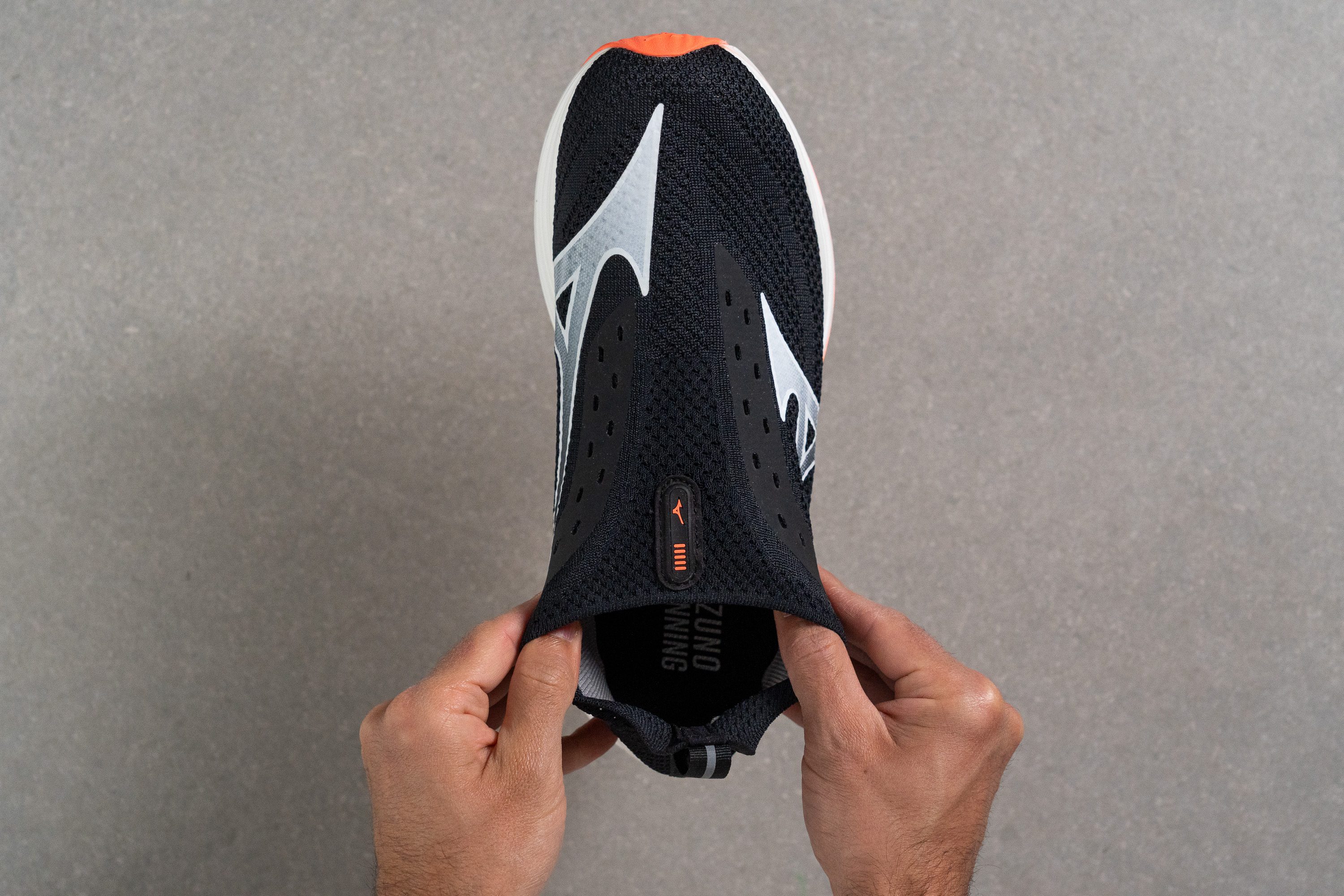
| Neo Zen | Tipo calcetín |
Precio
Las Neo Zen ofrecen algo poco habitual por su precio: una pisada llena de rebote y energía combinada con un upper de knit tipo calcetín. Si esto es lo que estás buscando, su relación calidad-precio es difícil de superar, la verdad.
| Neo Zen | $150 |
Tirador del talón
Como muchas zapatillas de running con un upper de knit, las Neo Zen tienen un tirador que hace que calzarse sea mucho más fácil.
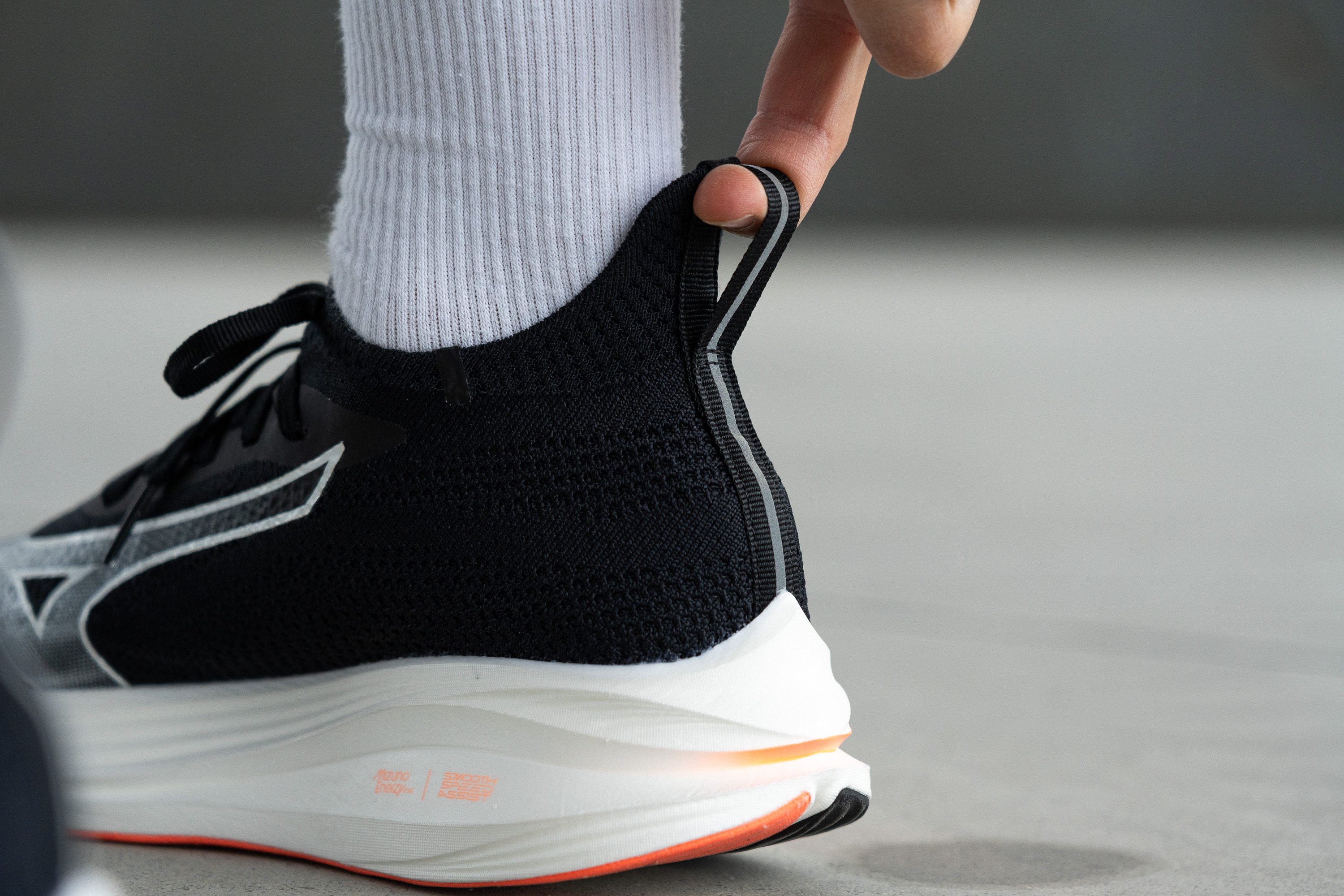
| Neo Zen | Tirador circular |

